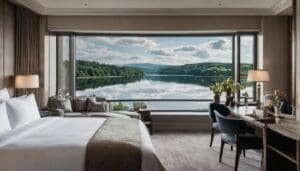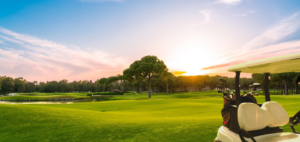Lombardy, Ultimate Guide to Enjoying this Soul-Filling Region
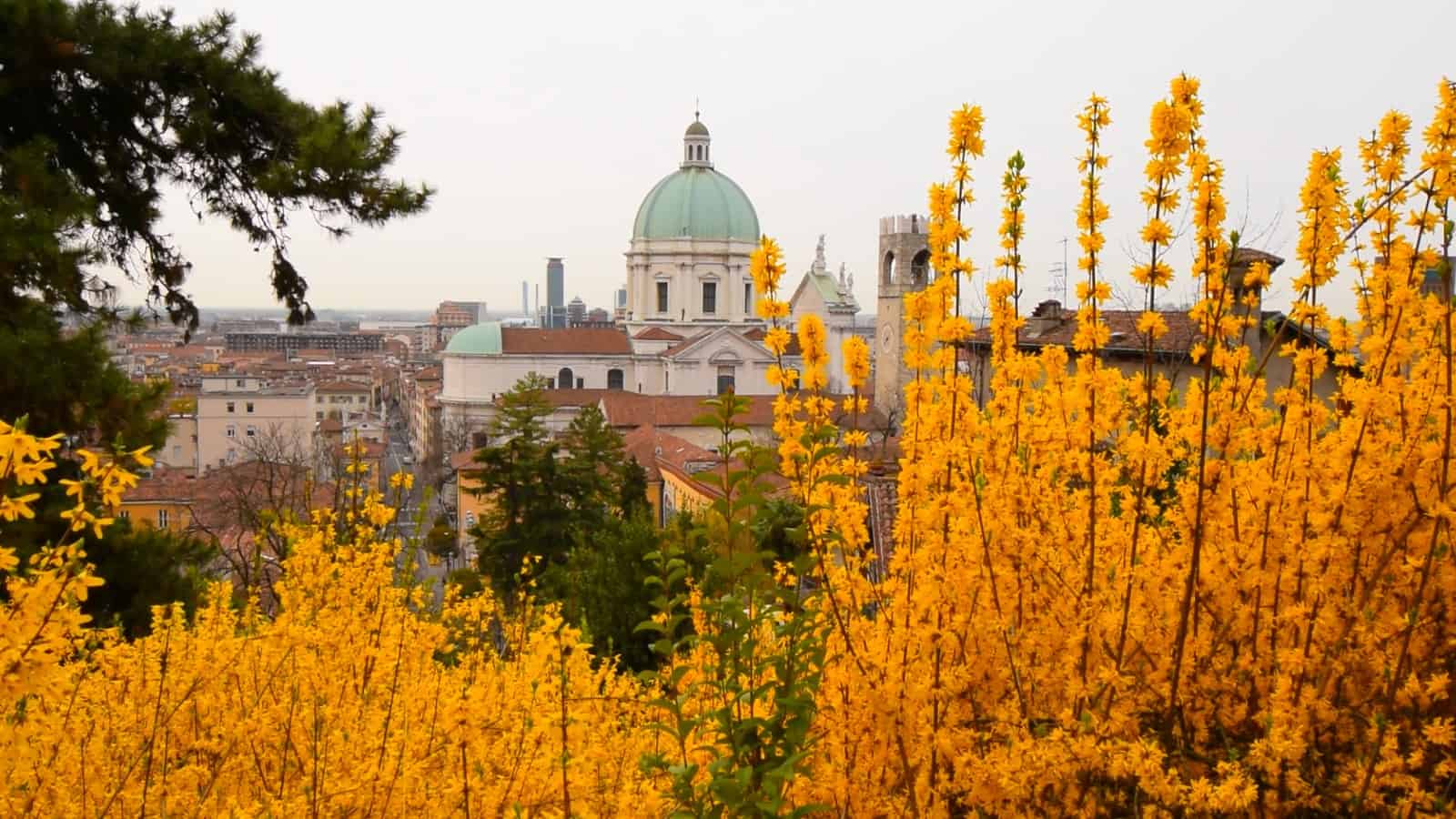
Updated On: November 08, 2023 by Aya Radwan
The region of Lombardy in the northwest of Italy, is one of the most populated, richest and most productive regions in Italy. The population of Lombardy represents more than one-sixth of the population of Italy.
The region is so rich in history that it is considered to be the Italian region with the most UNESCO World Heritage Sites. Of the region’s most famous cities is Milan with its metropolitan area that’s the largest in Italy and the third most functional urban area in the EU!
Sharing one of its borders with Switzerland, the weather in Lombardy mainly depends on the natural zone you’re in; mountains, hills or plains. This is also due to the proximity to inland water basins, local variances in elevations and large metropolitan areas.
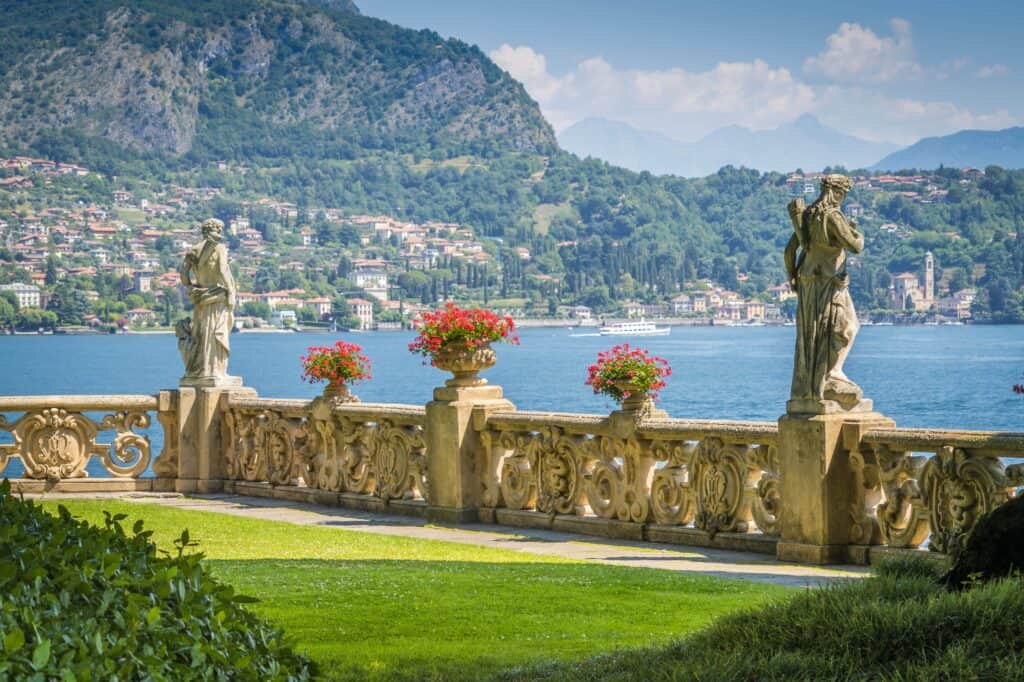
Mainly, the weather in the region is humid subtropical, especially in the plains, though the main winter weather is lengthy, damp and rather cold with the presence of fog. The oceanic climate in the Alpine foothills is motivated by the presence of lakes which is the ideal environment for the growth of Mediterranean crops such as olives.
The hills and mountains have a humid continental climate while in the valleys it’s usually mild with lots of snowfall during the winter season.
A bit of history about Lombardy
The region of Lombardy witnessed the rise and fall of numerous civilizations and empires. While archeological findings suggest the area of the current Lombardy has been settled at least since the 2nd millennium BC.
Lombardy thrived under the reign of the Roman Empire, the construction of many new roads and the development of agriculture and trade made the region one of the most developed and richest areas in Italy.
The region suffered again after the fall of the Roman Empire, only to return to its former glory. It fell under the control of several occupiers such as the Germanic Lombards, the Habsburgs of Spain, Austrians and the French armies under the lead of Napoleon until the Second Italian War of Independence took place.
In 1859, Lombardy was annexed to the Kingdom of Italy and the Lombardy in its present state was inaugurated. This surviving region has booming industries in agriculture, aerospace and defense, electronics, furniture and has an epicenter of fashion in the city of Milan.
Let me assist you in planning your next trip. We’ll get to know how to get to Lombardy, its most prominent monuments, the delicious culinary treats that await you along with the festivals and events you can catch while being in the area.
How to get to Lombardy?
1. Fly in:
The nearest airport is in Milan. There are three available airports you can choose from. The first is Milan Linate, where the Milan trams dispatches a bus to take you from the LIN to Via Larga Altezza P.Za Fontana with the average time of 30 minutes.
Second, Malpensa Airport T.1 has an hourly train; Malpensa Express under your disposal that would take you to Milan in about 40 minutes. The ticket will cost a maximum of 16 Euros.
Third, the flight to the airport of Bologna will take a little less than two hours and with a cost of a maximum of 140 Euros
2. By train:
Lombard’s capital Milan serves a strategic rail hub. Trains from all over Europe will get you to Milan. There are many railway companies that you can choose from. Companies such as Trenord manages suburban and regional railways. While Trenitalia operate regional, national and high speed international routes to get you to the heart of Lombardy.
3. By car, motorcycle or camper:
Lombardy has an extensive road network that you can easily reach by car. Among the many roads designated for taking the journey are, not exclusively, the A1: Connects Milan to Naples, via Bologna, Florence and Rome. Also, the A9: Starts in Lainate and continues as a two-lane motorway to Ponte Chiasso and Switzerland, via Lake Como.
What to do in Lombardy?
With a rich region like Lombardy, it’s easy to get overwhelmed by what to do once you get there. The region is rich in UNESCO World Heritage Sites. Let’s first explore the religious heritage of Lombardy, its theaters and museums, natural sanctuaries, fashion scene, festivals and events and the mouth-watering cuisine.
Religious Heritage of Lombardy
1. Duomo di Milano (The Milan Cathedral):
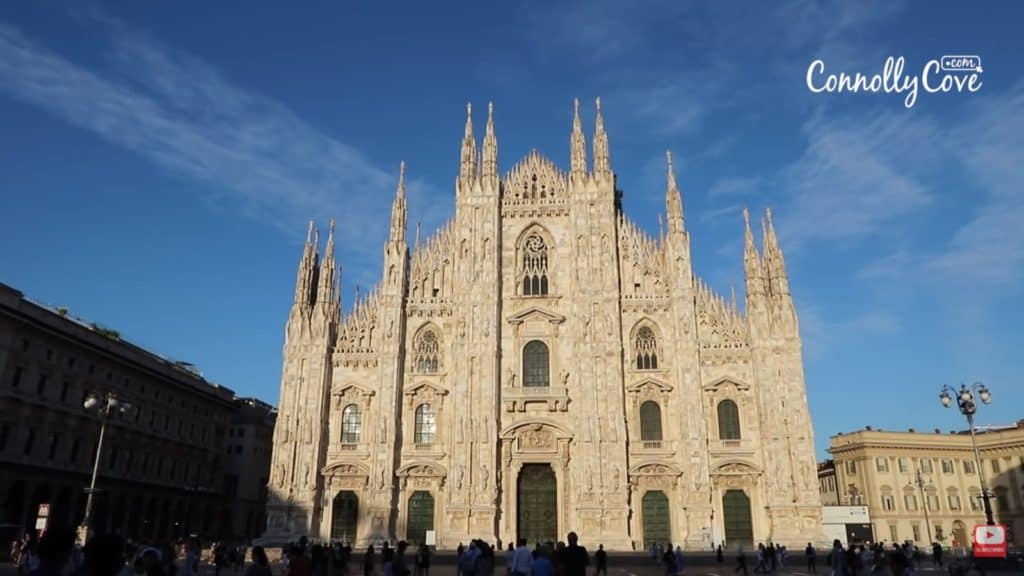
This cathedral has taken a striking 6 centuries to complete. Construction began in 1386 with the final details of the cathedral finished in 1965. It is the largest cathedral in Italy, the second largest in Europe and third in the world. The cathedral is dedicated to venerating the birth of Mary, mother of Jesus Christ.
The construction history of the Duomo is so rich, it’s easy to get lost reading it. The cathedral was meant to follow the Lombard Gothic style by the first chief engineer Simone da Orsenigo.
In the years that followed, two French engineers, each at a time, to assess the works done. Almost half the cathedral was complete in 1402 after which construction stopped until 1480 for the lack of funds and ideas.
Some decorations of the interior took place from 1500 to 1510 including the octagonal cupola. Carlo Borromeo strived for a more Renaissance appearance of the cathedral. His chief engineer Pellegrino Pellegrini designed a Roman style cathedral with columns, obelisks and a large tympanum.
Appointed engineers during the 17th century fluctuated between continuing the work on the Roman style cathedral or revert back to the Gothic style. Following the orders of Napoleon, the cathedral’s construction continued in the Gothic style and works were finally finished decades later 1965.
There are countless monuments and works of art inside the cathedral. For example, the statue of Saint Bartholomew Flayed; the cathedral’s most famous statue stands at the left of the altar. There are three magnificent altars by made by Pellegrino Pellegrini, and display Federico Zuccari‘s Visit of St. Peter to St. Agatha when she was jailed.
In the days around the birthdate of Saint Charles Borromeo a series of large canvases, the Quadroni are exhibited along the nave of the cathedral.
To continue the improvement of the cathedral, a video installation by English artist Mark Wallinger in September 2005. It is installed in the cathedral’s crypt, beside the relics of Saint Charles Borromeo.
The installation titled Via Dolorosa is an 18 minute film reproducing scenes of the Passion excerpted from the film Jesus of Nazareth by Franco Zeffirelli.
It is worth mentioning that people looked at the Duomo with different eyes, some marveled at its wonders while others perceive it as ugly and unartistic. American writer and journalist Mark Twain was of the former category while Oscar Wilde is actually of the latter group.
2. Santa Maria delle Grazie (Holy Mary of Grace):
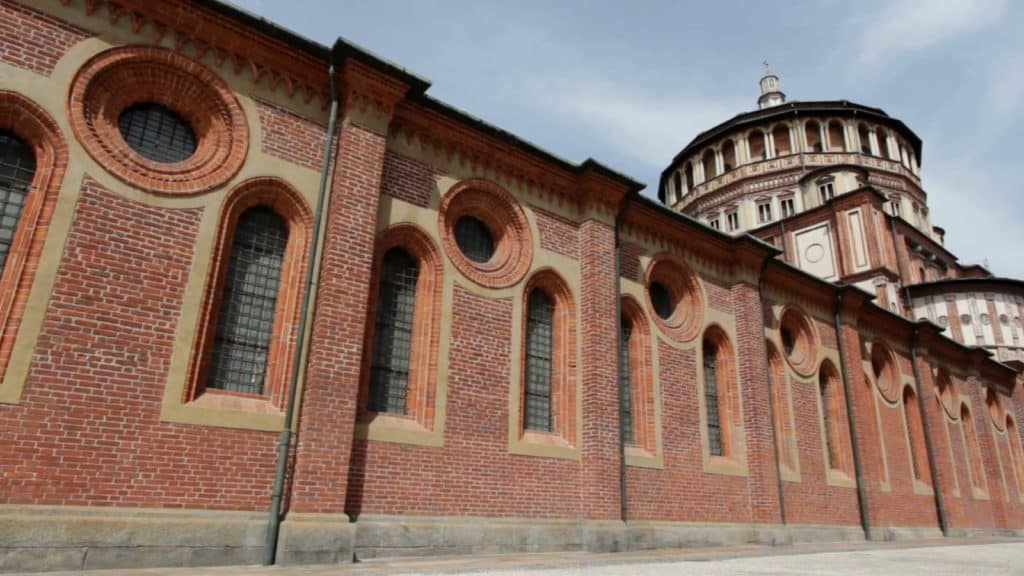
This UNESCO World Heritage site is a church and Dominican convent in Milan. The church houses the famous mural “The Last Supper” by Leonardo da Vinci. The convent was built first on the site of a prior chapel that was dedicated to the Marian devotion of Saint Mary of the Graces and works were finished in 1469.
There were many frescos that cover the walls of the church. Frescos such as Stories of the Passion by Gaudenzio Ferrari are an example. The church suffered great damage during the Second World War.
While the mural of The Last Supper survived, many frescos didn’t make it. Though the latest restoration works are said will protect the mural for centuries to come.
The Old Sacristy is the seat of the Dominican Cultural Center. Conferences and activities are held in the center pertaining to spirituality, art, philosophy and literature in addition to musical concerts and art exhibitions.
3. Basilica of Sant’Ambrogio:
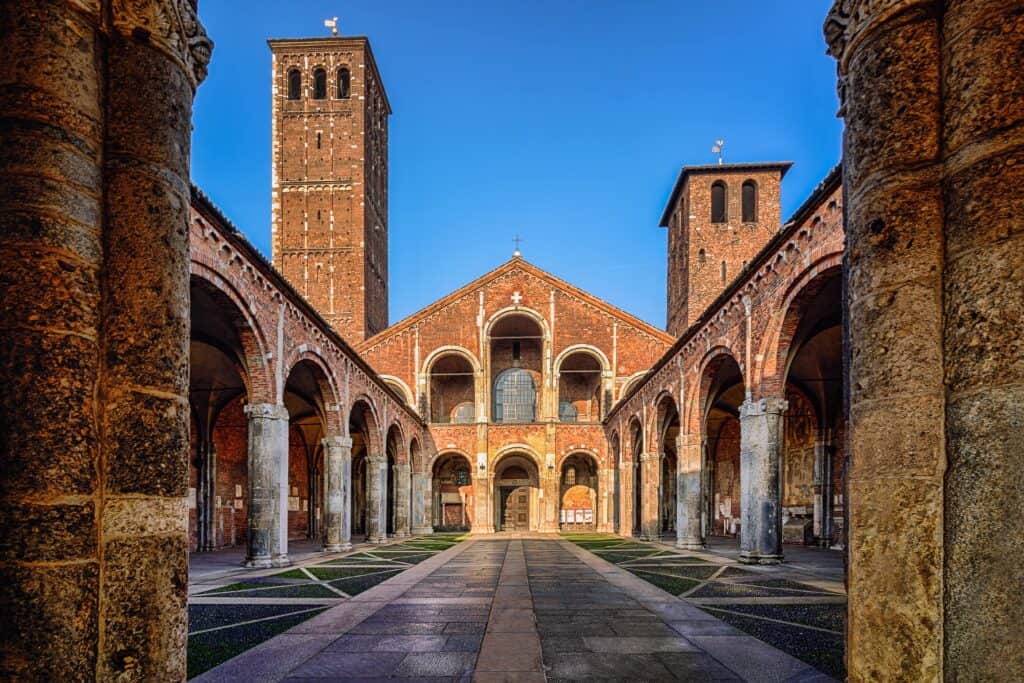
The church built in 379–386 by St. Ambrose is one of the oldest churches in Milan. The first name of the church was Basilica Martyrum seeing as it was built on the burial place of many martyrs. The current Romanesque style of the church dates back to the 12th century, after the church underwent several restorations.
The basilica was originally outside the city of Milan except the city kept growing and eventually engulfed the basilica to be at its center. The two towers of the basilica symbolize the division in the basilica; as two separate and distinct religious communities shared the basilica.
The 9th century tower (Tower of the Monks) was used by the monks to call the faithful to the monks’ mass. The canons, on the other hand, didn’t have a bell tower hence weren’t allowed to ring bells until they’d finished their tower which happened in the 12th century.
The edifice of the church underwent several restorations throughout the centuries, as it settled on its current look in the 12th century. The plan of the original edifice was maintained.
A rather interesting and symbolic myth concerns a while marble column with two holes in it beside the church. It’s alleged that the devil made these two holes as he hit the column in frustration after his failure to seduce Saint Ambrose. This probably explains why this column is dubbed “The Devil’s Column”.
Saint Ambrose built three or four churches surrounding the city of Milan. San Nazaro in Brolo (previously Basilica Apostolorum), San Simpliciano (previously Basilica Virginum) and the Basilica Martyrum. The church of Basilica Salvatoris (now San Dionigi) is attributed to him as well, while it may not actually be from the 4th century.
4. Basilica of San Lorenzo Maggiore (Basilica of Saint Lorenzo):
This church located with the city’s ring of canals, is one of the oldest churches in Milan. Built between the late 4th and early 5th centuries, the exact date of establishment is not clear nor are the names of who commissioned the building or designed it. What’s certain is that at the time of its construction, the basilica was the largest, centrally planned building in the West.
The dedication to Saint Laurence the martyr was certified only from the year 590, during which Milan was already occupied by the Lombards.
Numerous disasters befell the church in the 11th and 12th centuries. The terrible “Fire of the Stork” devoured the basilica in 1071 ruining the internal decorations. Earthquakes threatened the stability of the complex which deemed restoration works a necessity in the 12th and 13th centuries.
Throughout the middle ages, the basilica remained a symbol of legacy of the Roman Empire. Its classical architectural canons were admired by humanists, architects and artists such as Da Vinci and Bramante.
In 1573, the dome of the cathedral suddenly collapsed, luckily with no casualties. The construction of the new dome began right afterwards and the dome was finished in 1619.
All around the basilica you can find The Park of the Basilicas which used to be houses built leaning against the basilica. The Austrian Government in the 1830s demolished these houses, the channel of the Vetra was covered and executions were abolished.
After Second World War bombings, these houses weren’t rebuilt, giving the way for the development of the park.
In the square facing the basilica, the “Colonne di San Lorenzo” or the “Columns of Saint Lorenzo” are featured. They were carried into their current place after the basilica was finished.
They are one of the few remains of the Roman Mediolanum, dating back to the 3rd century AD. They are said to belong to the large baths built by the emperor Maximian.
5. Basilica of Sant’Eustorgio:
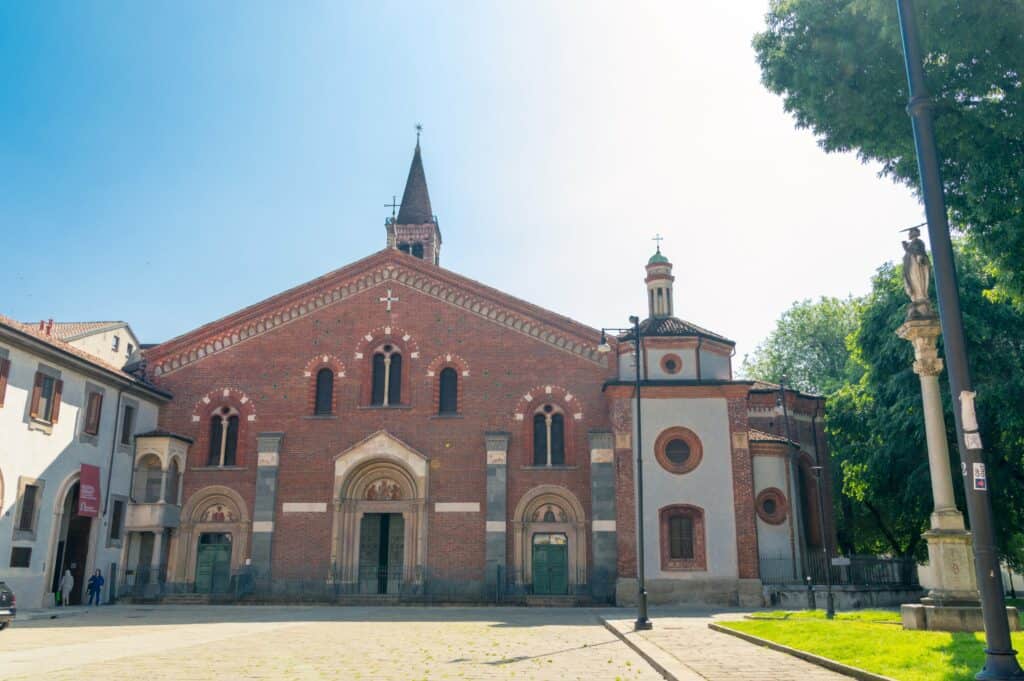
It is one of the churches in the Basilicas Park city park in the city of Milan. The church was an important stop for pilgrims on their way to Rome, as it was said to hold the tomb of The Three Magi or Three Kings.
Allegedly founded in the 4th century, the church’s name refers to Eustorgius I who translated the supposed relics of The Magi. This is due to the discovery of a Christian burial after the removal of a pillar, that had coins of Emperor Constans; the son of Constantine the Great.
6. Basilica of Santa Maria Maggiore:
An important church in the upper town of Bergamo, this church was built on the site of two previous church and temple. Once a church from the 8th century dedicated to St. Mary which had been established on the ruins of a Roman temple of the Clemence.
Local stories, supported by some documents, say that the church was built to comply with a vow made to the Virgin Mary in 1133 by the people of Bergamo to protect the city from the plague which was ravishing Italy at that time.
There’s an inscription on the portal of the south entrance that states the church was found in 1137. More work was done in the years of 1185 and 1187, after which the works lagged for the length of the 13th and 14th centuries.
Works resumed in 1436 while during the period from 1481 to 1491, the old sacristy was replaced by Bartolomeo Colleoni to build his personal mausoleum, the Colleoni Chapel.
The structure of the church is very interesting. Such as the fact that the church opens right on the square of Pizza Duomo on its left side; the main façade has no entrance due to being once united with the Bishop’s Palace.
The church can be accessed by two entrances by Giovanni da Campione and by Isabello’s Porta della Fontana. The columns that support Giovanni da Campione’s porch in the left transept are supported by lions in white marble.
7. Cappella Colleoni (Colleoni Chapel):
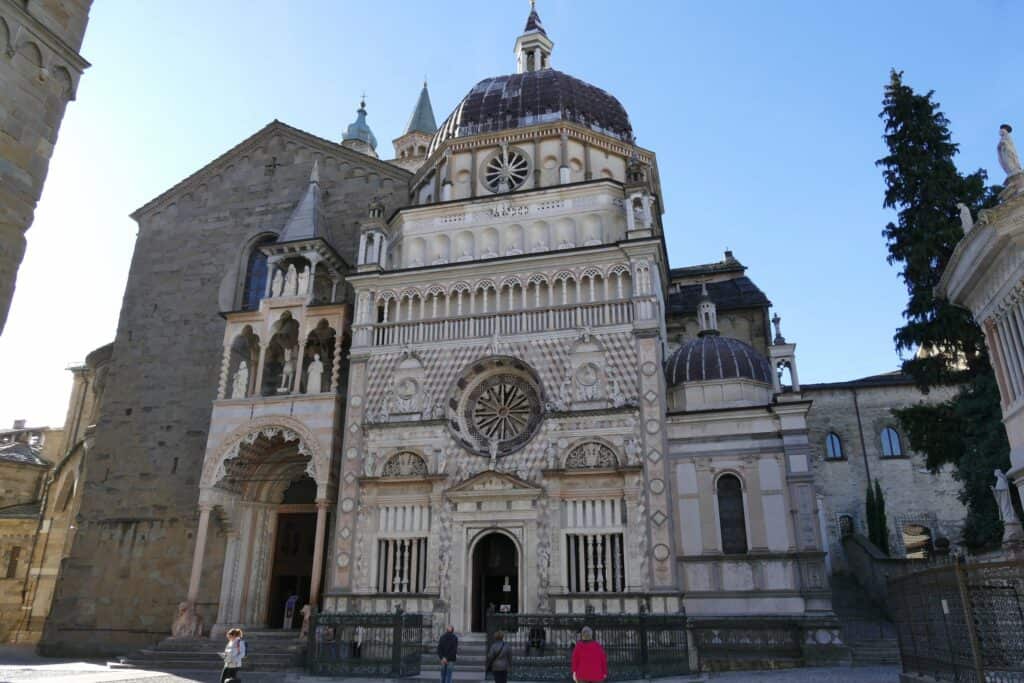
This is a chapel and mausoleum that are attached to the Basilica of St. Mary Major. The construction works took from 1472 to 1476 and the chapel was built to be the personal shrine of one of the members of the city’s most notable families, Bartolomeo Colleoni and his daughter Medea.
Even though Colleoni’s soldiers demolished the old sacristy to erect the chapel, it’s still debatable whether the demolition was authorized by the church administrators or not. The church is dedicated to three saints; Saint Bartholomew, Saint Mark and John the Baptist.
The design of the chapel by Giovanni Antonio Amadeo respected the style of the church. This is evident in the octagonal tambour of the dome, in the lantern cusp as well as in the use of polychrome marbles. Over the main portal of the church is a rose window; a symbol of Gothic style cathedrals and churches.
A funerary monument of Medea Colleoni who died in March 1470 is located on the left wall of the chapel. It has a statue of the Disposition from the Cross in high relief. The tomb was transferred here in 1892 from Basella di Urgnao.
After his death in November 1475, it was believed that Colleoni’s remains were buried elsewhere even though his tomb is on the wall facing the entrance of the chapel. This was due to the fact that the sarcophagus appeared empty and this belief went on for centuries. On November 21st, 1969 the remains were discovered in Colleoni’s tomb in a wooden coffin and hidden under a plaster cover.
8. Duomo Vecchio (Old Cathedral):
This Roman Catholic Church stands next to the Duomo Nuovo (New Cathedral) in Brescia, Lombardy. This cathedral is also known by the name “La Rotonda” because of its round layout and it’s also officially known as the Winter Co-Cathedral of Santa Maria Assunta.
The earliest documents found place the start of the construction work around 1100 on the site of a prior church with a basilica layout. The Duomo Vecchio is one of the most significant Romanesque round churches that still exist to this day.
There are 13th century frescoes on the interior walls and a large canvas by Francesco Maffei showing the church with a bell tower, which later collapsed. Many of the additions to the original medieval building were removed in the 19th century. After which the entrance portal was added.
The cathedral houses the medieval crypt of San Filastrio, in honor of the beatified Brescian bishop. The Duomo Vecchio has beautiful frescoes such as l’Assunta and St. Luke, St. Mark and the Sleeping Elijah by Moretto da Brescia. As well as a Translation of the Bodies of Saints by Francesco Maffei.
9. Duomo Nuovo (New Cathedral):
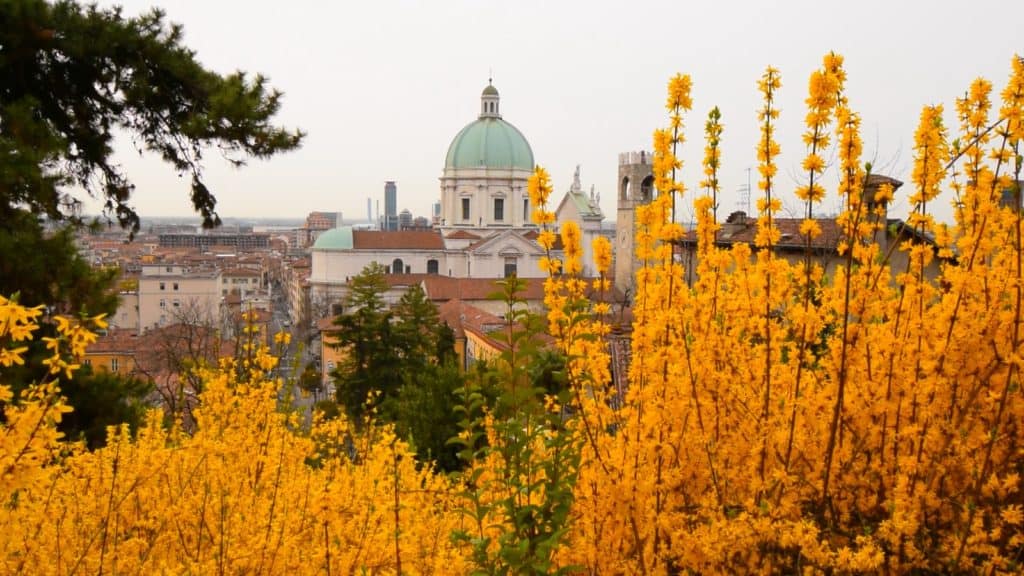
This is the largest Catholic Church in the community of Brescia in the region of Lombardy. The cathedral was constructed on the site where the paleo-Christian 5th and 6th centuries Basilica of San Pietro de Dom was located.
Construction works began in 1604, were interrupted by a season of the plague in around 1630 and only finished in the 19th century. The cathedral’s dome was the last piece to be added to the puzzle and completed in 1825. It is one of the highest domes in Italy with the height of 80 meters.
The present dome, however, was rebuilt after destruction by the bombing in the Second World War. The façade contains statues of the Virgin of the Assumption and of the Saints Peter, Paul, James, and John. The Duomo Nuovo is known as the Summer Cathedral of Santa Maria Assunta.
10. Duomo di Como (Como Cathedral):
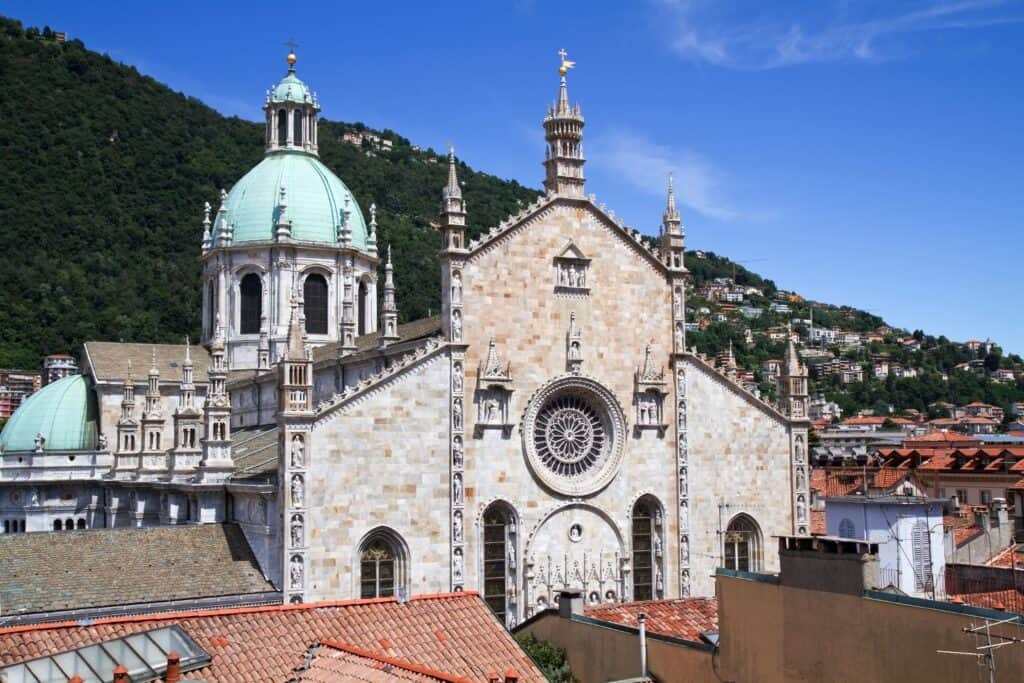
Located near Lake Como in the city of Como in Lombardy, the cathedral is one of the most important in the region. The cathedral’s dedication is to the Assumption of the Blessed Virgin Mary.
Construction works started in 1396 on the site of the earlier Romanesque cathedral dedicated to Santa Maria Maggiore, 10 years after the foundation of Milan Cathedral.
The cathedral’s imposing west front was built between 1457 and 1498, it features a rose window and a portal between two statues of Pliny the Elder and Pliny the Younger, natives of Como. Construction works were finished in 1770 with the completion of the Rococo cupola.
The interior of the cathedral is home to a number of 16th century paintings by Bernardino Luini and Gaudenzio Ferrari. Along with some important tapestries, and others of the 16th and 17th centuries made in Ferrara, Florence and Antwerp. The cathedral is often described as the last Gothic cathedral to be built in Italy.
11. Basilica of Sant’Abbondio:
This 11th century Romanesque style church is located in Como in the region of Lombardy. As per the usual of many Italian churches, the edifice of the basilica rises over a preexisting 5th century Palaeo-Christian church dedicated to Saints Peter and Paul.
The church was initially intended to house several relics of the two saints which Saint Amantius of Como had brought from Rome, was built at the distance of 1 kilometers outside the city walls.
The basilica was rebuilt in Romanesque style between 1050 and 1095 which was dedicated to Amantius’ successor, Abundius. The structures of the Palaeo-Christian Church discovered in a restoration in 1863 are still marked by black and pale marble stones in the pavement.
The church has two bell towers located at the end of each of the external aisles. The external decoration of the choir’s windows are not to be missed. In the apse, there’s a beautiful circle of mid-14th century frescoes. Abundius’ relics lay under the high altar.
The recently restored medieval monastery that’s annexed to the church currently acts as the seat of the local Faculty of Jurisprudence.
12. Duomo di Cremona (Cremona Cathedral):
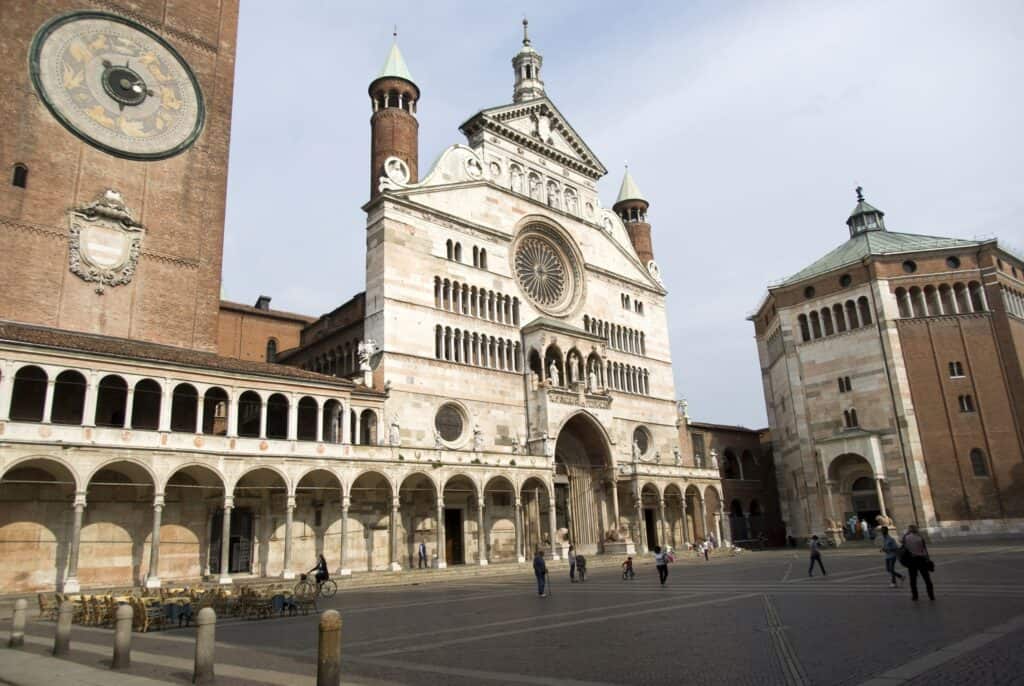
A Catholic Cathedral dedicated to the Assumption of the Blessed Virgin Mary in the city of Cremona, Lombardy. The bell tower of the cathedral, Torrazzo, is a symbol of the city and is the tallest pre-modern tower in Italy.
The cathedral was originally built in Romanesque style, yet elements of Gothic, Renaissance and Baroque nature were added during several restoration works over the years. Construction had begun in 1107 and came to a halt due to an earthquake in 1117. Works resumed in 1129 and the building was probably finished in the period from 1160 to 1170.
The main altar, consecrated in 1196, is dedicated to the two patron saints of the city Archelaus and Himerius. The current facade was probably built in the 13th and early 14th centuries. Together with the adjoining baptistery, the main facade are of the most important monuments of Romanesque art in Europe.
13. The Torrazzo:
Stands at a height of 112.54 meters, the Torrazzo, is the known as the third tallest brickwork tower in the world. The bell tower of the Cremona Cathedral is the oldest brick structure taller than a 100 meters and still standing.
Construction works are said to have begun in 754, when in reality the tower was built in four phases. The first in 1230s, up to the third dripstone was built.
The second between 1250 and 1267, up to the dripstone under the quadriphore was built. Third phase in 1284 and the last is the marble spire in 1309.
Embedded in the wall at the base of the Torrazzo tower is a plaque that announces the height as 250 arms and 2 ounces; the ancient measuring system of the Lombard towns. The Torrazzo comprises of seven bells, all tuned in the scale of A major. There’s also the “Ringing Bell” which strikes the hour.
The largest astronomical clock resides in the 4th story of the tower. The mechanism of the clock was built between 1583 and 1588. The paintings on the exterior of the clock symbolize the sky with the zodiac constellations with the sun and moon moving around them.
The clock’s hands are four, except one of them is a double making the hands’ count to be five. The clock signifies a lot of astronomical phenomena such as eclipses, Lunar phases and solstices.
14. Tempio Civico della Beata Vergine Incoronata (Civic Temple of the Crowned Blessed Virgin):
Considered to be one of the masterpieces of the Lombard Renaissance art, it’s located in a very narrow street near the Piazza della Vitoria, the city of Lodi most famous square, Lombardy. The design of the church was laid in 1488 by Giovanni Battagio.
The bell tower was built in 1503 while the façade was completed in 1879. The church has an octagonal shape with a dome with the same shape with a lantern at the top. A huge art gallery is housed inside the church, with artworks from the late 15th century to the early 19th century by the prominent artists in Lodi.
15. San Pietro in Ciel d’Oro (Saint Peter in Golden Sky):
Is a former Catholic Cathedral, now a basilica in the city of Pavia, Lombardy. The name is to refer the mosaics of gold leaf behind glass tesserae that decorate the ceiling of the apse.
A church of Saint Peter in Pavia is recorded in 604 which was renovated between 720 and 725. The church is one of the Romanesque style churches in Italy and was consecrated in 1132.
Even though the tomb of Augustine of Hippo was installed in the basilica, remade in 1362, his actual remains were the subject of controversy. The body was said to have been removed to Cagliari, Sardinia, later returned by Peter, bishop of Pavia to the Church of Saint Peter around the year 720.
In 1695, stonemasons working in the crypt discovered a marble box with fragments of wood, numerous bones, bone fragments and glass vials inside. Some of the workers later claimed they read the name Augustine written with charcoal on the top of the box. This sparked a heated debate that went on till 1728 when Pope Benedict XIII intervened approving the authenticity of the bones discovered.
Once more the remains along with their guardians, The Augustinians, found themselves out of the city in 1700 while the cathedral in Pavia needed restoration works. Reconstructions took place in the 1870s, the church was re-consecrated in 1896 when the relics of Augustine and the shrine were reinstalled.
16. Basilica of San Michele Maggiore:
Dating back to the 11th and 12th centuries, this striking example of Lombard-Romanesque style is in the city of Pavia, Lombardy. The current church was built in the place of the first church dedicated to Saint Michael Archangel, which in turn was built on the location of the Lombard Palace chapel.
The old church was destroyed in a fire in 1004. Construction of the current building began by the end of the 11th century and was completed by 1155. The vaults of the nave were replaced in 1489.
17. Certosa di Pavia:
One of the largest monasteries in Italy till this very day, it was built between 1396 and 1495. The Certosa is built in both the Gothic and Renaissance styles with a fine collection of artwork that best represents the region.
The site of the complex was strategically chosen between Milan and Pavia. The church was the last building to be built, was intended to be the mausoleum of the Visconti. The construction of the church began in Gothic style, however, as the Renaissance style started spreading, the rest of the church was completed in such style.
18. San Maurizio al Monastero Maggiore:
The church was originally attached to the most important female monasteries in the city of Milan. The entire complex was founded in Lombard times. Construction of the church began in 1503 and was finished 15 years later.
The church’s edifice was divided into two parts, one for the faithful and one for the nuns. The most important art work in the church is the cycle of the 16th century frescoes covering the walls. The dividing wall has frescoes showing the Life of San Maurizio.
The hall of the nuns is fully painted as well. The partition wall presents works by Bernardino Luini of the 16th century. Works such as images of Saint Catherine, Saint Agatha and the Carrying of the Cross of Christ.
Nowadays the church is open every Sunday from October to June, to celebrate in the Byzantine Rite, in Greek according to the Italian-Albanian tradition. At times, the church serves as a concert hall as well.
Historical Sites in Lombardy
1. Castello Sforzesco (Sforza’s Castle):
This castle built in the 15th century was considered one of the largest citadels in Europe in the 16th and 17th centuries. Built on the ruins of a 14th century fortification, this castle was built in the 15th century. The castle is now home to many of Milan’s museums and art collections.
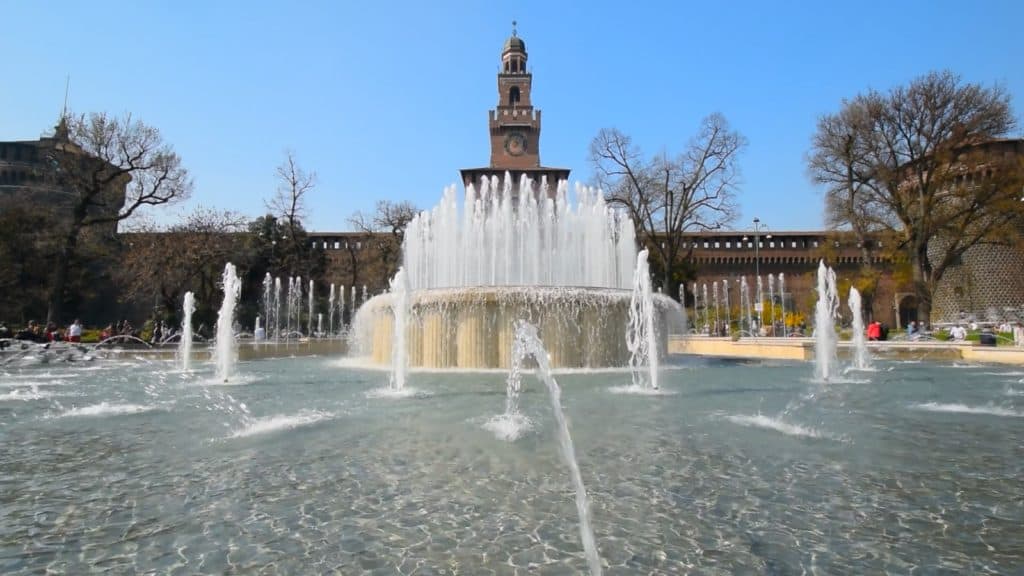
Works on the original structure took place from 1358 to 1370, during that time the castle was called Castello di Porta Giova or taking the name of a nearby gate called Porta Zubia.
The castle was later enlarged till it became a square-plan castle with 200 meters long sides. Back then the castle was the main residence if the city’s Visconti lords until it was destroyed in 1447 by the Golden Ambrosian Republic.
Reconstruction works began again in 1450, in 1452 the central tower, still known as the Torre del Filarete was built. In 1476, during the time of Bona of Savoy, the tower bearing her name was built.
Starting from 1494, several artists were called upon to decorate the castle. Rooms were frescoed by artists such as Leonardo da Vinci while Bramante painted frescoes in the Sala del Tesoro. Around 1498, Leonardo worked on the ceiling of the Sala delle Asse painting motifs of vegetables.
The castle suffered continuous damages in the following years. Such as assaults from Italian, French and German troops and the placement of mines under the castle’s foundations on orders of King Francis I of France. Being used as a weapons’ depot led to the explosion of the Torre del Filarete.
The castle became a citadel under Spanish rule in 1535. In 1550 works began to reinforce the fortifications of the citadel. Twelve bastions were added changing the original pentagonal shape of the citadel into a hexagonal shape. External fortifications extended to about 3 kilometers.
While the Austrians took over Lombardy, most of the outer fortifications were demolished under Napoleon’s rule. The establishment of the semi-circular Pizza Castello was constructed around the city side of the castle. The area on the country side of the castle was turned into a 700-by-700 meter square called Piazza d’Armi.
Following the unification of Italy in the 19th century, ownership of the citadel was transferred to the city of Milan and restoration works began right afterwards.
The most significant of the works is the opening of Via Dante to provide a direct road between the castle and The Duomo. Between 1900 and 1905, the Torre del Filarete was rebuilt.
The castle is home to many museums which we will now explore.
- Museo d’Arte Antica (Museum of Ancient Art):
This art museum has a large collection of sculptures from the late antiquity, Medieval and Renaissance periods. The frescoed rooms of the museums house an armory, a tapestry room, some funerary monuments and two medieval portals.
The Sala Verde or the Green Room is home to 15th and 16th century structures, the collection of arms from the Castello Sforzesco and the Portale del Banco Mediceo which is a gate removed from Via Bossi.
Another collection of arms in the second part of the room contains sculptures, armor and swords in chronological sequence from the Middle Ages to the 18th century.
- Pinacoteca del Castello Sforzesco (Literally The Picture Gallery of Sforzesco Castle):
This art gallery was inaugurated in 1878, it displays over 230 works that include masterpieces by talented artists such as Titan, Canaletto, Pisanello, Giovanni Bellini, Lorenzo Lotto and others.
The total works in the museum are more than 1,500 works, due to the fact that the collections have been enriched in the last two centuries by donations of illustrious citizens and collectors.
The first rooms in the Pinacoteca are dedicated to religious paintings of the 15th and 16th centuries. Art works by Bergognone, Carlo Crivelli and other Lombard and Italian Renaissance painters. The famous the Trivulzio Madonna by Andrea Mantegna dating back to 1497.
The second half of the Pinacoteca houses artworks from the 16th, 17th and the 18th centuries. This half includes both secular and religious works from artists such as Titan and Bernardo Bellotto. The museum is also home to some portraits of members of the Sforza family from 15th and 16th centuries.
- The Museum of Musical Instruments:
Over 700 of musical instruments from the 15th to the 20th centuries are on display in the museum, with great attention paid to Lombard instruments. The musical collection includes plucked instruments, hunting horns, Lombard and Cremonese violins and various wood instruments such as flutes.
The Cremonese lutherie is well appreciated all over the world for the high quality of its musical instruments. The equipment of the former Studio di fonologia musicale di Radio Milano are also on display in the museum.
- Museo Egizio (The Egyptian Museum):
This museum is part of the Milan Archaeological Museum. The museum is located in the underground level of the ducal courtyard and is divided into seven sections.
About Ancient Egyptian Writing, About Pharaohs, About Deities and Cults, About Everyday Life for the Egyptians, About Funerary Cult, Excavations Conducted by Achille Vogliano, Mummies, Sarcophagi and Funerary Masks.
In the section of Mummies, Sarcophagi and Funerary Masks there’s a mummy dating back to the Greco-Roman period and ancient Egyptian sarcophagi. Some papyrus of the Book of the Dead is on display in the Funerary Cult section.
- Civico Museo Archeologico di Milano in Italian (The Archaeological Museum of Milan):
It’s located in the ex-convent of the Monastero Maggiore, along the ancient church of San Maurizio al Monastero Maggiore.
The first part of the museum is dedicated to the history of ancient Milan or Mediolanum founded in the 4th century BC and conquered by the ancient Romans in 222 BC. A small section is dedicated to Gandhara’s arts takes place on the basement.
The inner cloister which houses Roman remains (1st to 3rd century AD) and two medieval towers are visible, connects the first part of the museum with the new building in Via Nirone. The Early Middle Ages section, the Etruscan section, the Ancient Greek section and the temporary exhibition room all exist in that first part.
There was a polygonal tower from the Middle Ages situated in the inner cloister expose a sculpture by Domenico Paladino which he donated to the museum. Collections from prehistoric and Egyptian civilizations are on display at the Castello Sforzesco Museums.
Statues and tombs from ancient Rome are displayed along the cloisters of the former monastery, a path leads from the cloisters to a polygonal tower (late 3rd century) with early medieval frescoes (13th century) and comes out in the new museum in Via Nirone.
- Raccolte d’Arte Applicata di Milano (The Applied Arts Collection of Milan):
This museum is divided into several sections emphasizing jewelry, ivories, pottery and art glass. The ceramic collection in the museum includes medieval, Renaissance and Baroque pottery.
Pieces from the 17th century exist in the maiolica group from Lodi and Milan and a collection of European chinaware and earthenware.
The collection of artistic glass includes the Cup Gonzagna, made of crystal clear glass and decorated with small golden flowers and the Gonzaga coat of arm with a quadripartite black eagle on a white background.
In the Sala Della Balla is the Arazzi Trivulzio, a series of twelve tapestries representing the different months of the years. The design is inspired by drawings of Italian painter Bramantino.
- The Antique Furnishings and Wooden Sculpture Museum:
It is located on the first floor of the Sforza Castle ducal courtyard. Artifacts are chronologically arranged from the 14th century up to the modern times with particular attention paid to the Italian and Lombardic furniture history.
The Chamber of Griselda is one of the most important artifacts exposed in the museum. It’s a wooden room reconstructed with 15th century detached frescoes to create a replica of how it looked like in its original location in the Roccabianca Castle near Parma.
The 20th century furniture design and Italian design are well represented by furniture signed by Carlo Bugatti, Ettore Sottsass and Alberto Issel. The 18th century Italian school of cabinetmakers is well represented by several cabinets signed by Giuseppe Maggiolini.
Religious furnishings from the 16th to the 18th centuries along with furniture of the noble families of Milan are also on display. Several wooden sculptures and various decorative items, such pottery or tableware including a tea set designed by Gio Ponti, are also displayed in the museum.
- The Achille Bertarelli Print Collection:
Even though Betarelli obtained a degree in Law and worked in helping his father manufacturing furniture, he had a love for prints. Soon after he started collecting and catalogue in in his Milanese home in Via San Barnaba.
The reason of Bertarelli’s collection of collecting printed materials of exceptional aesthetic quality is to acquire the largest number of iconographic documents as a unique way to document historical figures, events and locations.
One of the collector’s special collection is called “Popular Prints” which is divided into “Sacred” and “Profane” that are on display at the Castello Sforzesco. This collection still provides a rare and precious window on all aspects of daily life and on the evolution of tastes and customs.
The stamp collection was granted the name of its founder in the year 1938; the same year Bertarelli died, to honor his great efforts of putting together this collection over the course of more than 13 years.
- The Museum of the Rondanini Pietà:
This museum houses the last sculpture by Michelangelo named Rondanini Pietà. Michelangelo has been working on this sculpture from 1552 until the last days of his life, in 1564.
The name Rondanini refers to the fact the statue stood for centuries in the courtyard at the Palazzo Rondinini in Rome. The sculpture embodies the Virgin Mary mourning over the emaciated body of Jesus Christ.
Michelangelo’s last series of drawings called “The Crucifixion” and the sculpture of the “Deposition of Christ” which was intended for his own tomb. The Rondanini was produced at a time when Michelangelo’s sense of mortality was growing. He worked on the sculpture all day, six days before his death.
It’s been suggested that the Rondanini should not be considered “unfinished work” rather a continuous process of being made visible to the viewer as they move around it to see it from multiple angles.
May 2015 is the year the Rondanini found a home at the Sforza Castle. Originally held in a room by the BBPR architects in the 1950s, they pushed for a new dedicated museum to be established. After years of heated debate, this unique work of art found home in a museum dedicated solely to it.
The way the Rondanini put on display at the museum serves the continuous effect of the sculpture. Upon entering the room, the visitor will see the Pietà from behind; the last part carved by Michelangelo. The visitor will see the Virgin Mary as she mourns over the dead Christ.
Only by walking around the statue and facing it that they’ll be able to see the frail body of Jesus Christ supposed by his beloved mother. This way of presenting the sculpture emphasizes the unfinished part of the sculpture, in a way helping the visitor to appreciate this fact about it.
- The Archivio Storico Civico e Biblioteca Trivulziana:
The library and archive holds a manuscript by Leonardo da Vinci called The Codex Trivulzianus. The library offers many services such as a reading room, reproductions, educational activities, books and documents and projects. The library opens on Wednesdays at 10:00 am.
2. Villa Reale (Royal Villa of Monza):
This neoclassical palace is located in the community of Monza on the banks of the river Lambro, the region of Lombardy. It’s surrounded by one of the largest enclosed park in Europe; Monza Park.
The villa was built between 1777 and 1780 on the instructions of Empress Maria Theresa of Austria to be the summer residence of the Archduke Ferdinand of Austria.
Even though the Monza was chosen because of its serene location in the countryside, the real reason was that it was a symbolic link between Vienna and Milan; as it is on the way to the Imperial Capital.
The addition of the gardens took some years after the palace was built. The villa is built in an inverted U-shape plan, it was reused to combine the strong scenic impact that the side wings give to the main façade. The central setting was used for gatherings, while private apartments and the avant-corps for service functions were on the side.
The palace complex includes the Capella Reale (Royal Chapel), the Cavallerizza (horse shed), the Rotonda dell’Appiani, the Teatrino di Corte (Small Court Theater) and the Orangerie. The first floor rooms consist of salons and halls and the Royal apartments. In front of the palace are the royal gardens.
The Orangerie; the greenhouse or as it’s now known as the Serrone, is located on the north side of the villa. A corridor called “Passage of the Ladies” connected the Orangerie to the palace. The building gets plenty of sunlight from the south from a long series of windows.
The villa was used as the Royal Palace and was home to the Viceroy of Italy during the Napoleonic Kingdom of Italy. The structure of the villa was improved, adding the theater on the north wing.
The entire complex of the villa and its garden was extended between 1806 and 1808 through the construction of the fenced park called Monza Park. The 14 kilometers long wall was built exactly between 1807 and 1808 using the demolition material of the ancient Visconti’s castle.
Under the reign of the Kingdom of Lombardy-Venetia, the Monza was included in the province of Milan. The new Archduke; Ranieri was passionate about botany, in 1819 he ordered the construction of a school in the park that trained professional gardeners to care for the gardens of imperial residences.
Thanks to Ranieri, the park and garden of the Monza became rich in new species. Ranieri ordered the modernization of the villa, specifically the apartments specified for his sons and daughters, which in turn had magnificent decorations. The last Archduke to settle in the Monza was Archduke Maximilian in 1857.
When the new Kingdom of Italy was established in 1861, the villa was used as the palace of the Italian Royal House of Savoy. This was short-lived as the palace was abandoned in 1900 after the assassination of King Umberto I as he attended a sports event organized in the Monza.
In 1934, most of the villa was donated to the municipalities of Monza and Milan by royal decree. Vittorio Emanuele III only kept the southern portion with his father’s apartment, King Umberto I but was to remain closed in his memory.
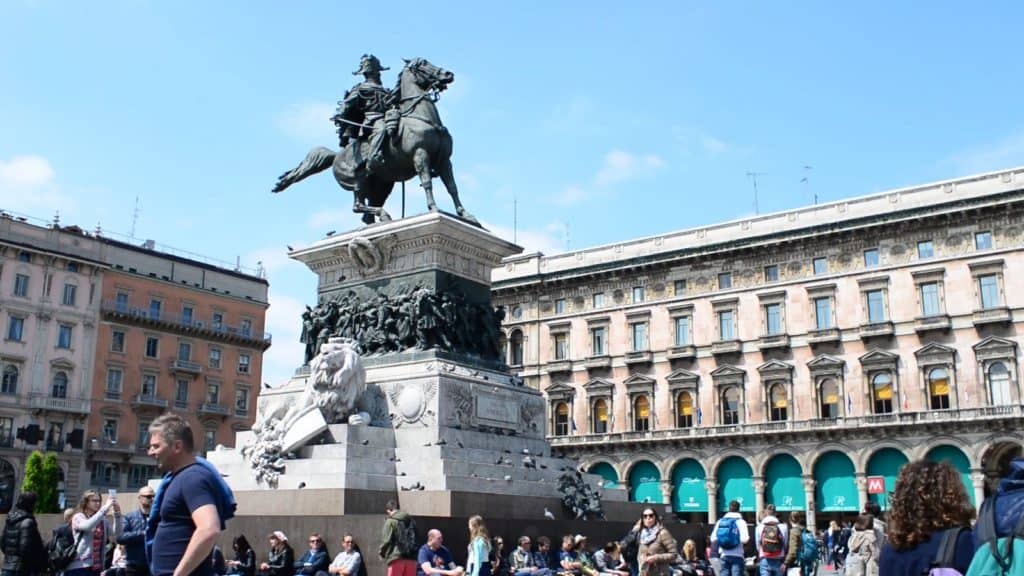
After the Second World War, the villa withered away. Ever since the establishment of the Italian Republic, the villa was administered by the municipalities of Monza and the Region of Lombardy.
Left to decay after the Second World War, plans to restore and renovate the villa began in 2012, ending on the 26th of June 2014 with the inauguration taking place on the 8th of September.
Restoration works included, not exclusively, works on the central body, the north and south wings, consolidation of the walls on the ground floor, restoration of the pavement, the gate and the south façade.
The royal apartments of King Umberto I Margherita di Savoia that still keep a part of the original furnishing are now open to visitors. Nowadays, the villa hosts exhibitions including the orangerie and there’s a wing that’s home to the Artistic High School of Monza.
3. Villa Toeplitz:
Built in 1901, this villa is located in the city of Varese in the region of Lombardy. It holds the name of the banker Giuseppe Toeplitz who bought the villa in 1914. Its beautifully designed gardens, scenic fountains and water features render it one of the ten most beautiful parks in Italy.
The villa currently houses the headquarters of the Faculty of Communication Sciences of the University of Insubria as well as the Ethno-Archeological Museum Castiglioni.
Built towards the end of the 19th century, the villa is built in the center of a complex of orchards and farm buildings. It’s one of 120 villas in a municipality that has 73% of the landscape protected. When Toeplitz bought the villa, he substantially renovated it according to plans inspired by his wife until the works were completed in 1926.
Originally created as a summer residence for the German Frey Family in 1901. After Toeplitz bought the villa, he commissioned its renovation except that these works were not finished until after the First World War in 1918. One of the main modification works was the expansion of the surrounding park.
The villa’s park includes the main villa, the residential villa and the porter’s lodge. The park was divided into several parts: the orchard; a lawn area; access roads to the Villa; patches of shrubs and groups of trees; a “wood” of conifers and exotic plants and a lookout.
There’s a chapel on the upper part of the property; a hornbeam rock; areas for bowls, tennis courts and croquet games; a flower garden; a swimming pool (today a pond); and, a wood-aged chestnut.
Internal renovations of the villa included building an attic above the first floor, a small balcony on the east side and a tower with a metal dome where an astronomical mirror was installed.
One of Toeplitz’s important projects was a full hydraulic engineering project to transfer water from the nearby Monte Martica river into the garden’s attractions. These water features are no longer functional.
The main building was completed near the end of the 1920s after which the villa became a place of cultural and artistic meetings. Mainly, these meetings were under the care of Toeplitz’s second wife; Edvige Mrozowska; a Polish dancer and actress.
The exterior of the villa has many distinguished features. Such as the use of serliana and above the windows there are lunettes and gables, generally painted or decorated. Another feature is the cover of the loggia above the main entrance and that of the tower are wooden coffered ceilings.
The interior of the villa has marble staircases, parquet floors in the rooms, ceramic in the service rooms and painted wooden doors. The reception on the ground floor remain unchanged and is still furnished as it was in the days of the Toeplitz family, with inlaid chessboard tables, a bar corner in solid wood and antique armchairs.
One of the most important renovations commissioned by Toeplitz was the construction of a tower crowned by an arched loggia, four on each side. The arches support the roof structure with an openable metal doom used as a scientific observatory.
The high tower drew suspicions during the Second World War; the Germans thought the tower was used by Toeplitz for secret communications. Suspicions even reached Toeplitz’s wife that led her to sell the palace at the end of the Second World War. In 1972 the building became a property of the municipality which began using it as a school.
Toeplitz literally thought of everything, so he thought about the prominent figures he welcomed into his home. These figures included the writer Matilde Serao and the Agnelli.
The building – guest house – Toeplitz designed to serve such a purpose utilized the characteristic materials of Lombard architecture. Its decorations were in colored bands, mainly in blue and gold to stand out in the upper part. Which was typical of early 20th century architecture.
Today Toeplitz’s guest house is home to the Castiglioni Museum. The museum houses a massive ethno-archaeological collection of thousands of finds, donated by brothers Alfredo and Angelo Castiglioni to the municipality of Varese.
The two brothers spent 60 years researching in the archaeological, anthropological and ethnological fields throughout the African continent. They collected and categorized artifacts of many ethnic groups and documented everything with photographs.
The archeological section on the ground floor houses Egyptian and prehistoric finds. Exhibits on how gold was mined at the time of the Egyptian pharaohs and the origin of the emeralds used since the time of Cleopatra are among many others that tell the Egyptian history.
Upstairs in the ethnographic section, you’ll see findings of traditional populations from savannah and desert environment. These include exhibits of the typical elaborate hairstyles of the Nile Camiti and shepherds of the African savannah (Kenya, Tanzania, Uganda).
The Toeplitz Villa’s gardens are a staggering 80,000 square meter garden. They’re connected by pathways running through a connected system of exotic plants, fountains and buildings. The park was designed in 1927.
The gardens are divided into two main gardening styles. The first; a “specifically formal” style which is characterized by low boxwood bushes and cypress trees. The boxwood tree and the ivy trees were both used in creating topiary bushes and balloons. The second is an “English landscape garden” with beech trees, oaks and cedar trees.
At present time, a part of the park is specified for a large chestnut wood penetrated by tracks leading to a deep nature contacting experience. There’s a natural pathway running through a chestnut wood in the northern part of the gardens, from the southern entrance of the gardens to the northern one. The pathways is made of “sinuous and romantic” alleys with small hills and “elegant” iron gazebos dotted here and there.
Once water games and water shows took place at the garden, utilizing the numerous fountains adorning the garden. Now, however, these games and shows ceased to take place due to the dryness of the source that used to aliment the fountains.
Since Varese’s economy had what was called “Chestnut Economy”, it was no wonder Toeplitz paid great attention to this particular tree. The chestnut wood in the Toeplitz Villa’s garden was planted when the family first moved into the villa. The perfect weather of Varese contributed to the thriving of the wood.
The chestnut wood is located in the north-east part of the gardens; the English landscape garden. Chestnut trees are an important source of raw materials. The wood is used to make furniture, barrels and roof beams and as firewood to name a few.
Another important function of the chestnut wood is its role in beekeeping; bees are attracted by the male chestnut flowers which results in a huge honey supply.
The monumental fountain of the villa is located on the side of a small hill and is divided into three levels. The lowest level is located at the center of the main boulevard that goes from the entrance to the actual Villa.
The middle level is divided into another three parts accurate and symmetric, surrounded by hedges of shrubs and a complex mesh of canals, tanks and water games.
On the third level there are many fountains and terraces that lead to a nymphaeum, decorated with granite columns. A water chain from the 15th century connects all three levels of the fountains and is made up by pink porphyry tanks.
The chapel built by the Toeplitz is located atop the hill, behind the belvedere. The chapel is decorated by frescos painted by Jan Henryk Rosen di Leopoli, who’s also responsible for the beautiful artwork in St. Ambrogio; where Toeplitz and his second wife are buried.
Toeplitz asked for permission to build a panoramic bridge in order to facilitate the connection between the Gardens and the other side of the street. The construction of the bridge finished in 1924.
Apple, pear and peach trees with the espalier technique were in the orchard, this technique helped the tree have a flat structure. Both Toeplitz and his wife Edvige Mrozowska, had strong passion for floriculture and fruit farming but Mrozowska in particular.
Mrozowska often entered and won several competitions and gained honors as well, all thanks to the interesting way of cultivating the apples and pears. Toeplitz on the other hand was really dedicated to the care of his plants in the greenhouse. He checked on them every night, no matter how late it was.
Villa Toeplitz’s Gardens once hosted a series of bird snares dedicated to bird hunting, an activity that long practised by Mr Toeplitz. There’s also a tower that’s developed into three levels, each with a different function.
The lowest for meetings, the middle one was where the birds rested and or beckoned other birds and the top level was used by the hunters to look for birds.
The botanical collection of the Toeplitz garden reflects the historic influence and international travels of Mrs. Toeplitz during the garden’s original creation. The chestnut forest is home to many wildlife forms, insects, amphibians, and small mammals, some of which are relatively rare.
These species live undisturbed because the forest is rarely visited by humans. Recently, the population of frogs and toads has increased. In the middle of April 2019, over 300,000 tadpoles and larvae have been moved from an area affected by restoration work in the park and they have been rehoused in the central pool in front of the Villa.
This allowed for the recognition of several, both common and rare amphibians that will populate the park’s wooded area, enriching their biodiversity and relevance.
4. The Palazzo Estense:
This Baroque palace in Varese, was designed and completed in 1760. Francesco III d’Este, Duke of Modena and Austrian governor of Lombardy, purchased it in 1765 with the intention of making it his home.
In the present, the palace houses the Civic Administration of the Local Municipal Council and hosts conferences and concerts. A G6 Interior Ministers meeting was hosted there in May of 2010.
5. Villa Recalcati:
Built in the first half of the 18th century, this Baroque style palace is in the province of Varese, Lombardy. An enlargement of the structure took place between 1756 and 1776.
At the beginning of the 20th century, the palace was sold and transformed into the Varese’s Grand Hotel Excelsior. In 1927, Varese became the Province’s capital and in 1931, the building was bought by the provincial institution.
6. The Castello di Masnago (Masnago Castle):
This castle is located atop a hill in Mantegazza Park in Masnago, Varese. The oldest part of the castle which is now a civic art museum, is an 11th century worn-out tower, rebuilt over the centuries. On the ground floor there’s a frescoed room and in the first floor there are two exhibition rooms. Some of which are from the 15th century.
The Mantegazza Park – Parco Mantegazza – has a small botanical garden which has a variety of trees, shrubs and typical Mediterranean vegetation that you can admire. Since the castle stands on top of a large lawn, it’s the perfect place to forget about everything and enjoy the company of a good book.
7. Castelseprio (Archaeological Park):
This park used to be a fort and a town of Lombard in the early Middle ages before getting destroyed and abandoned in 1287. The park which is in the commune of Castelsprio, Province of Varese, Lombardy is best known for the Early Medieval frescoes in the apse of the small Church of Santa Maria foris portas.
The frescos were only discovered in 1944 and are of exceptional rarity and artistic significance with strong Byzantine influence. Nowadays, the church and the castrum with the Torba Tower are considered a UNESCO World Heritage Site, as part of the Longobards in Italy, Places of Power.
The Lombards occupied the Roman fort turning it into a fortified or small town. At one point, coins were mined there which is a sign of importance. The church containing the famous frescoes are just outside the walls of the castle.
Following its capture, the whole castle was completely destroyed by Ottone Visconti, Archbishop of Milan in 1287, most probably to prevent it being used again by his rivals.
The entire area now is an archeological zone that includes remains of the walls, a San Giovanni Evangelista basilica from the 5th century, a baptistery of the 5th to 7th centuries, some ruins from the castle and nearby is a large tower that was once used as a convent.
Style and subjects of the frescoes: Upon the discovery of the frescoes in the church, many scholars believe the frescoes weren’t painted by one, but two artists. The works are sophisticated and confident, poses are natural and rhythmic.
While the iconography of the frescoes is clearly Byzantine, other aspects of the frescoes appear to be inspired by the Christian art of Syria and Egypt. The buildings and figures are more effectively managed in these frescoes than in most Byzantine painting and the paint is done with more artistic freedom than Byzantine work.
Some historians compare the style with which the frescoes were painted to the traditions of the city of Alexandria, Egypt. The Byzantine-style frescoes are painted around the curved wall of the apse and the inward surface of the arch between the apse and the main body of the church.
The condition of the frescoes vary, some are clear and beautiful, some are missing parts of them while others are barely visible or not at all. The subject of the frescoes are a matter of scholarly debate. Some argue that the frescoes are all connected telling the story of the Life of The Virgin Mary, while others argue they tell the story of The Life of Christ.
8. Longobards in Italy: Places of Power (568–774 A.D.):
This group of historical buildings reflects the achievements the Germanic tribe of Lombard, who settled in Italy in the 6th century establishing the Kingdom of Lombard. The group of monasteries, church buildings and fortresses became a UNESCO World Heritage Site in 2011.
This was a testimony of the Lombards’ important role in the cultural and spiritual development of Medieval European Christianity. Two of these sites are in the modern region of Lombardy.
Monumental Area with Monastic Complex of San Salvatore-Santa Giulia at Brescia: The complex includes the Convent of Santa Giulia, the Basilica of San Salvatore and the Roman Forum Archeological Area.
The convent of San Salvatore was founded in 753 and is characterized by using Longobard style and classic and ornate decorative motifs. It was restored several times throughout history and finally the Church of Santa Giulia was finished 1599.
Of the religious buildings, the oldest one goes back to the late first century BC. The building is characterised by the high level of conservation of its architectural and decorative parts, making this entire area a prominent architectural example of Northern Italy.
Castrum with Torba Tower and Church outside the walls, Santa Maria foris portas, at Castelseprio (Varese): The castle includes the Torba Monastery, the Santa Maria Foris Portas Church and the ruins of the San Giovanni Evangelistic basilica.
The Longobards turned the complex into a place for commerce and then a monastery. The ruins of the big Castelseprio Basilica are the only one still standing.
9. Rock Drawings in Valcamonica (Brescia):
These rock drawings are the largest collection of prehistoric petroglyphs in the world. In 1979, UNESCO classified the site as a World Heritage Site making it Italy’s first recognized heritage site.
At that time, UNESCO recognized more than 140,000 figures and symbols. New discoveries though have increased that number to range between 200,000 and 300,000 with drawings scattered all over the surfaces of the valley.
The vast majority of the petroglyphs were made on sub-glacially streamlined bedrock and glacial erratic services revealed as the last glacier to form the valley retreated about 15,000 years ago.
Many of the incisions were made over a period of time that’s over 8,000 years before the Iron Age. The latest petroglyphs are attributed to the people of Camuni.
Engravings from the Roman period, the medieval period and even of contemporary arts up to the 19th century have been identified. Most cuts have been made using the martellina technique and few were made with graffiti. A famous symbol adopted in Valcamonica is “Rosa Camuna” or Camunian Rose. This was also adopted as the official symbol of Lombardy.
Some symbols and figures could appear they’ve been superimposed with no sequence or relation tying them while others seem to have a logical relationship between them. This would explain some of the symbolism of the figures, it’s not about the figure or symbol itself, rather about the idea behind it such as pertaining to a celebratory ritual.
Archeologist Emmanuel Anati was among the first who systematically studied the area in the 1960s and drew up a chronology of rock carvings. He helped compare style and types of the symbols to better identify them with their historic period, starting from Prehistory to the Middle Ages.
According to Anati’s research, the drawings date back to six periods of time.
- Epipaleolithic, dating back to about 8th – 6th millennium BC (Proto – Camunian).
- Neolithic, around the 5th to 1st centuries of the 4th millennium BC (Camunian I).
- Chalcolithic (Copper Age), about 3rd millennium BC (Camunian II)
- Bronze Age was in the 2nd millennium BC (Camunian III).
- Iron Age was in the 1st millennium BC (Camunian IV).
- The Roman and Medieval Ages (Post Camunian). During the Roman ages the engravings nearly stopped while they went back to thrive during The Middle Ages.
10. The Fortified City of Bergamo:
This city, the fourth largest city in the region of Lombardy is part of a transitional system of fortifications built by the Republic of Venice. The massive Venetian defensive systems have been recognized as a UNESCO World Heritage Site on July 9th, 2017.
11. The Pinacoteca di Brera (Brera Art Gallery):
Being the main public gallery for painting in Milan, it contains one of the most prominent of Italian paintings and it shares the Palazzo Brera with the Brera Academy.
On the site of the Palazzo there’s a convent built in 1572, rebuilt in 1627 – 1628. A herbarium was added to the botanical garden in 1774.
12. Museo Nazionale Scienza e Tecnologia Leonardo da Vinci (National Science and Technology Museum of Leonardo da Vinci):
This museum in Milan is one of the biggest science and technology Italian museums and is dedicated to renowned Italian artist and scientist Leonardo da Vinci. The museum which is located in the ancient monastery of San Vittore al Corpo in Milan, is divided into several departments which are as follows:
1. Materials Section:
As the name suggests, this section deals with the life cycle of modern products from raw materials to recycling. Specific sections are dedicated to polymeric and synthesis materials to basic chemical manufacturing.
Another section is for metal which illustrates metal extraction and processing techniques and exhibits the first electric arc furnace for melting steel invented in 1898 by Ernesto Stassano.
2. Transport Section:
This section is divided into four main sub-sections:
- Air Transport Section exhibits several aircrafts including a Farman 1909 replica. There are also several modern military aircrafts like an Italian Fiat G.91.
- Rail Transport Section is a recreation of the 1906 Expo with an added reconstruction of a late 19th century railway station façade. The collections exhibits vehicles from the 19th and 20th centuries with focus shed on the history of public transportation in Lombardy.
- Water Transport Section displays the bridge of the transatlantic liner Conte Biancamano and also exhibits a slow running torpedo among many other exhibits.
- The last section talks about Toti-class submarine known as Enrico Toti, a work of art built by Italian shipbuilders after WWII for the Italian Navy and launched in 1967.
3. Energy Section:
Dedicated to energy sources and device, there are the Margherita thermoelectric power station (1895) and an oil industry/petrochemistry section.
4. Communication Section:
This section is divided into three sub-sections:
- The Astronomy Section: that showcases several antique astronomical and topographical instruments.
- The Telecommunication Section: All forms of modern era communication from the telegraph to the telephone and to wireless phones as well.
- The Sound Section which shows main technologies for sound recording and reproduction.
5. Leonardo da Vinci, Art and Science Section:
This section is divided into another four sub-sections:
- The Jewelry Section which shows precious objects from stones and gems to metals.
- The Leonardo da Vinci Section exhibits many Leonardo machinery reproduced from Da Vinci’s drawings.
- The Horology Section shows the evolution of watch-making and shows several pendulums.
- The Musical Instruments Section exhibits instruments from the 17th to the 20th century.
13. Accademia Carrara di Belle Arti di Bergamo (Accademia Carrara):
This art gallery and academy of fine arts in Bergamo, Lombardy was established in about 1780. The academy was added to the gallery in 1793 or 1794.
Giacomo Carrara who established the art gallery, stated in his will that his entire estate was to continue being dedicated to the art gallery and the academy. In 1810 a new building was added in the neoclassical style.
In 1958, the municipality of Bergamo took over the management of the art gallery and academy. The school was recognized under the administration of the Ministry of Education in 1988.
14. Tempio Voltiano (Volta Temple):
This museum in the city of Como, Lombardy is dedicated to Alessandro Volta who invented the electrical battery. The neoclassical style building was finished in 1927 to celebrate the 100th anniversary of the scientist’s death and was inaugurated in 1928. The museum shows a variety of scientific instruments used by Volta. The first floor has a display of his personal belongings and awards.
15. Villa Olmo:
This neoclassical villa is in Como, Lombardy and it was designed to be a summer retreat for the aristocracy. The villa was named after an elm tree planted in the middle of the ornate gardens, which is no longer alive today.
The municipality of Como acquired the villa in 1924, it is now open to the public only during exhibitions. While the lakeside gardens are easily accessible during the day.
16. Palazzo del Te (Palazzo Te):
This palace was constructed as a place of leisure for the Marquess of Mantua is a fine example of the manneriest style of architecture. It is located in Mantua, Lombardy and was constructed between 1524 to 1534.
In 1630, during the War of Mantuan Succession, both Mantua and the palace were sacked by an Imperial army of 36,000 Landsknecht mercenaries. The palace was looted from top to bottom and remained a mere empty shell. Part of the Palazzo today houses the Museo Civico del Palazzo Te, which contains a collection of Mesopotamian art.
17. La Scala (Teatro alla Scala):
This opera house in Milan, Lombardy was inaugurated in 1778 after a fire destroyed the previous theater in the city. The theater was built on the former location of the church of Santa Maria alla Scala from which the theater gets its name. The church was de-consecrated and demolished.
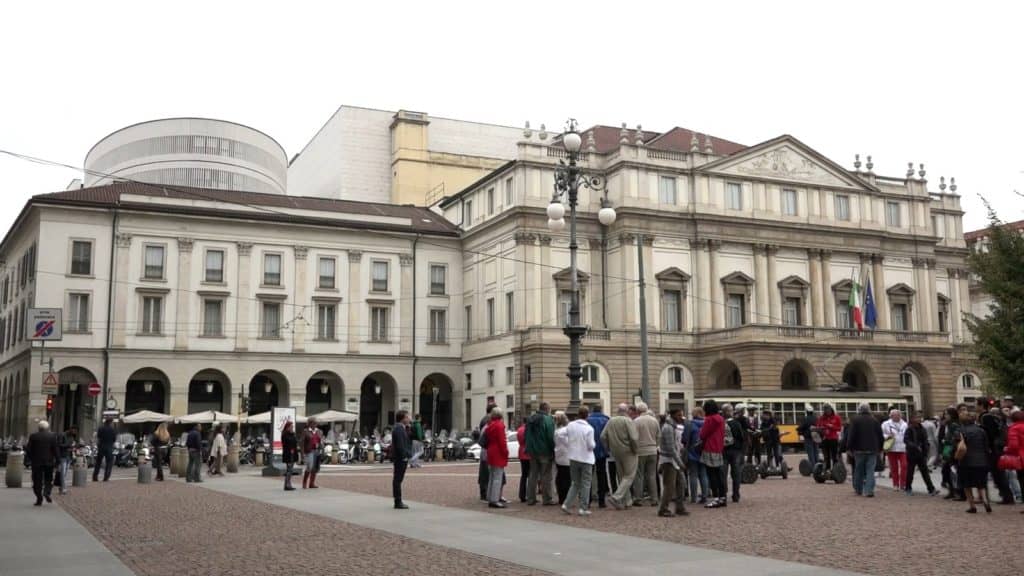
The theater was completed in the period of two years. In 1982, the Filarmonica della Scala orchestra was founded to assist in the development of a symphonic repertoire. A prestigious step to add to La Scala’s operatic tradition.
The theater recently underwent major renovations from early 2002 to late 2004. Most of Italy’s greatest operatic artists and some of the finest singers around the world have all performed at La Scala. The theatre is considered one of the leading in the world in the fields of opera and ballet.
18. Mille Miglia Museum:
The Mille Miglia car race was an open-road motorsport endurance race established in 1927 by the young Counts Francesco Mazzotti and Aymo Maggi. The race took place in Italy 24 times 1927 to 1957. Since 1977, the Mille Miglia was reborn as a regularity race for classic and vintage cars and participation is limited to cars produced no later than 1957.
Since November 2004, the former Monastery of S. Eufemia at Brescia houses the Mille Miglia Museum. Films, memorabilia, dresses, posters and a number of classic cars illustrate the history of the Mille Miglia car race.
19. Crespi d’Adda:
This village in the town of Capriate San Gervasio, municipality of Bergamo in Lombardy is a historic settlement and a striking example of the 19th and early 20th century “company towns” built in Europe and North America.
The site is still intact and is usually used for industrial purposes although changing economic and social conditions now threaten its survival. Since 1995 it’s been recognized as a UNESCO World Heritage Site.
The village was originally built to accommodate the conditions of the workers in the cotton mill installed by Cristoforo Benigno Crespi. The village was a residential area provided with social services such a clinic, a school building, a theater, a cemetery, a wash-house and a church. Today the factory is an open air museum of industrial archeology.
Production in the factory only stopped in 2004 with its main field of productivity was cotton textile production. Today, the village is inhabited by a community most of whom are descended from the original factory workers.
The parish church was built starting from 1891 and was opened on November 1893. The church was dedicated to Santa Maria dell’Aiuto. Until this present day, the church is used by the locals for ordinary religious rites.
Construction of the cemetery began in 1905 and was finished by November 1908. The cemetery is in fact a monumental construction where the mausoleum that’s dedicated to the Crespi family is the main core. The members of the Crespi family are buried in the mausoleum.
The castle of Crespi was built between 1893 and 1894. Built using Medieval architecture, the castle was the manor and summer house of the family. At the end of 1960, the municipality got a hold of the building’s property.
From 1968 to 1981 it became the secondary school of the village which later turned into a professional institute. Nowadays, the building was declared a place of historical interest.
20. Prehistoric pile dwellings around the Alps:
This multi-centered heritage site consist of 111 individual objects in Italy, France, Switzerland, Germany, Austria and Slovenia of which 10 are located in Lombardy. The objects are remnants of buildings erected on wooden piles (stilt house) in sub-alpine rivers, lakes and wetlands.
They were built between 5,000 BC and 500 BC. In general, only the submerged wooden parts have been preserved, although in some places pile buildings have been reconstructed.
21. The Rhaetian Railway in the Albula/Bernina Landscapes:
Although the railway is mostly located in the Swiss canton Graubünden, it also extends over the border into Tirano which is a town in Valtellina in the region of Lombardy.
This site is considered a UNESCO World Heritage Site because of the complex railway engineering (tunnels, viaducts and avalanche galleries) necessary to take the narrow-gauge railway across the main chain of the Alps. The two railway lines were opened between 1904 and 1910 on several stages.
I can almost sense that after all this sightseeing, a trip to the shores of a lake or a hike up a serene secluded mountain is the perfect way to clear your head. How about we discover the natural sanctuaries of Lombardy? The region is rich in mounts and lakes.
Mountains and Lakes in Lombardy
1. Monte San Giorgio:
This wooded mountain in Lugano Prealps – a mountain range in the western part of the Alps located both in Canton Ticino and Lombardy – overlooks Lake Lugano in Switzerland. The mountain acquired a UNESCO World Heritage Site status in 2003 due to being the single best known record of marine life in the Middle Triassic period and also has important remains of life on land.
2. The Sacri Monte of Piedmont and Lombardy:
This series of nine groups of chapels in Piedmont and Lombardy were created during the late 16th and 17th centuries. They are dedicated to various aspects of Christian faith.
They are considered of great beauty due to the skill with which they were integrated in the elements of the woods around them. They house important paintings and artistic materials and were named a UNESCO World Heritage Site in 2003.
The concept of a calvary or “sacred mountain” is a Christian creation that dates back to the 15th century. The calvary provided safe haven for those who wished to safely practice their faith at a time of Counter-Reformation. The chapels contain scenes from the life of Christ, the Virgin Mary or the Saints in the form of paintings or sculptures.
The sacred mountain is a place of pilgrimage for the faithful until this very day, almost as a re-evocation of the New Jerusalem. The Sacred Mountains offered pilgrims an opportunity to visit the Holy Places by conjuring up, on a smaller scale, the buildings in which Christ’s Passion took place.
Of the nine Sacri Monte with World Heritage Site status, two are in Lombardy. The Sacro Monte of the Rosary in Varese and The Sacro Monte of the Blessed Virgin of Succour, Ossuccio in the province of Como.
3. Lake Garda:
The largest lake in Italy is located in the north of the country, about halfway between Brescia and Verona. The lake and shoreline are divided between Verona, Brescia and Trentino. The lake’s Mediterranean climate about the lake makes it the ideal location for a vacation.
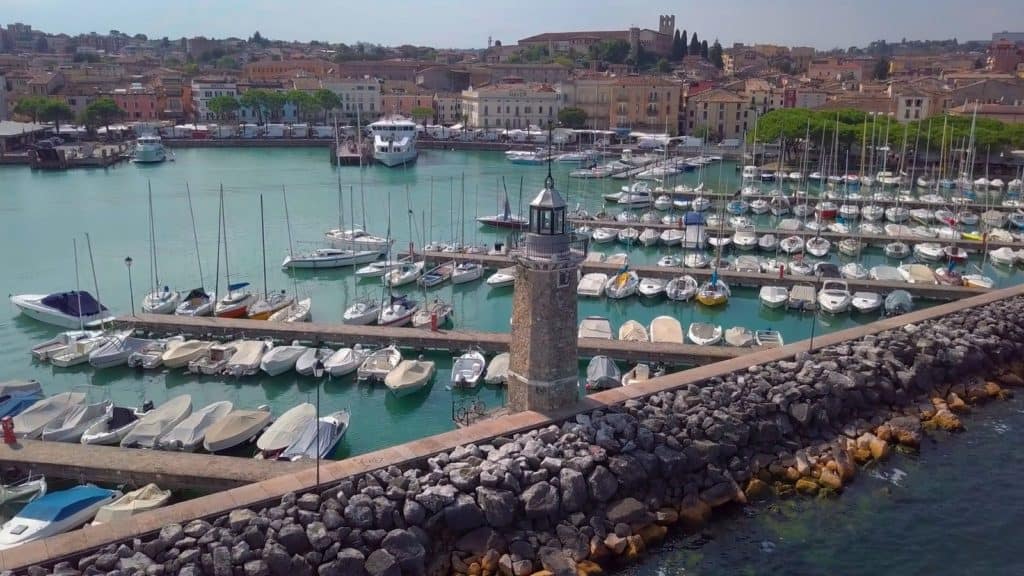
Several transportation services run to and from the lake and its surrounding communes. You can choose between ferry rides – not regular as only one fair could operate a day, using the railway or traveling buses which are considered a faster alternative to ferry services.
Lake Garda has been a witness to several historical events. Such as witnessing the Battle of Rivoli during the French campaign of Napoleon 1 in Italy against Austria in 1797. Also naval battels took place between Italy and Austria have taken place in the lake in 1866.
4. Lake Como:
The third largest lake in Italy, this lake is of glacial origin. It’s an area of 146 square kilometers and over 400 meters deep, it’s the 5th deepest lake in Europe. Since Roman times, the lake has been a serene gateway for aristocrats.
The lake is a very popular tourist attraction with many artistic and cultural gems. The lake is home to numerous villas and palaces such as Villa Olmo and Villa Carlotta.
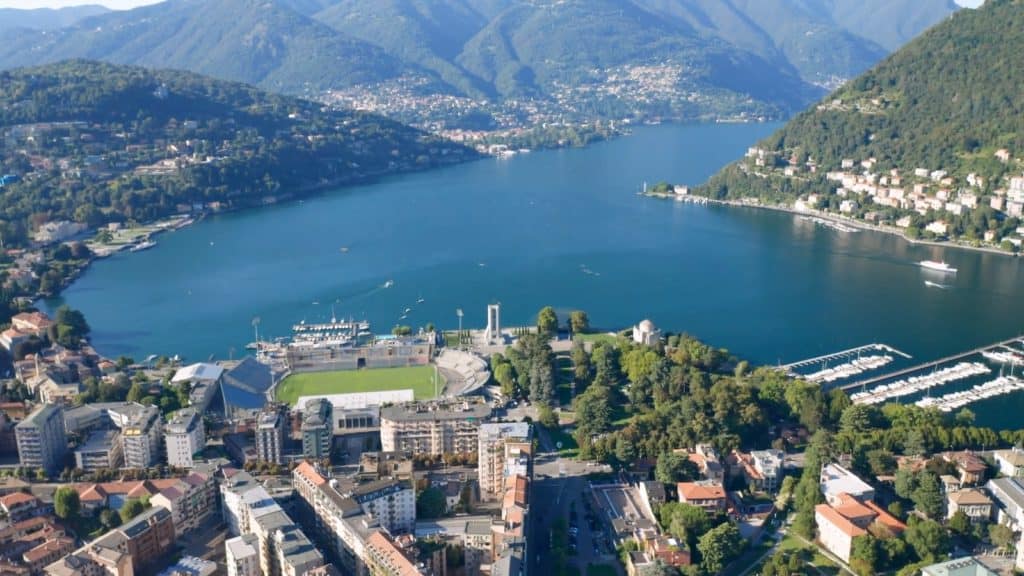
The weather at Lake Como is humid subtropical. The lake helps keep the temperatures higher in the region during winter season which makes it the perfect spot for winter vacation. Lake Como offers you breathtaking landscapes, wildlife and spas. You can enjoy sailing, windsurfing and kitesurfing.
Local farms are dotted in the area around the lake and they provide an array of local goods. You can find the farms yourself, it’s quite easy and you will be treating yourself to quality goods such as honey, olive oil, cheese, milk, eggs and salamis.
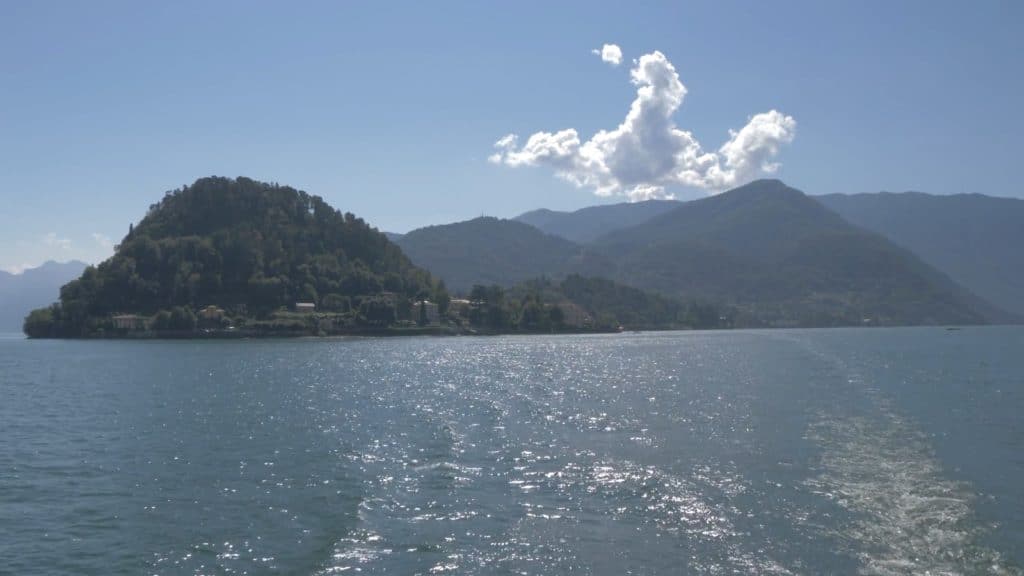
Lake Como is also know for the magnificent villas along its shores. Built since the Roman times, many villas have amazing gardens that flourish beautifully due to the mild climate created for them. This helps both subtropical and Mediterranean plants to thrive in these gardens.
One of the villas is Villa Carlotta which was built in 1690 houses an Italian garden with steps, fountains and sculptures was installed right after the villa’s construction. Today the villa today is home to an agricultural museum and important sculptural works as well.
Alongside the western edge of Lake Como there’s the Sacro Monte di Ossuccio which resembles The Sacri Monte of Piedmont and Lombardy. It consists of 15 Baroque style chapels built between 1635 and 1710 which are dedicated to the Mysteries of the Rosary. In 2003 it was added to the UNESCO World Heritage Sites.
5. Lake Iseo:
The fourth largest lake in in Lombardy is also known as Sebino. Lake Iseo has kept its natural environment despite the industrial nature of the towns in northern Italy. It’s equally divided between the provinces of Bergamo and Brescia.
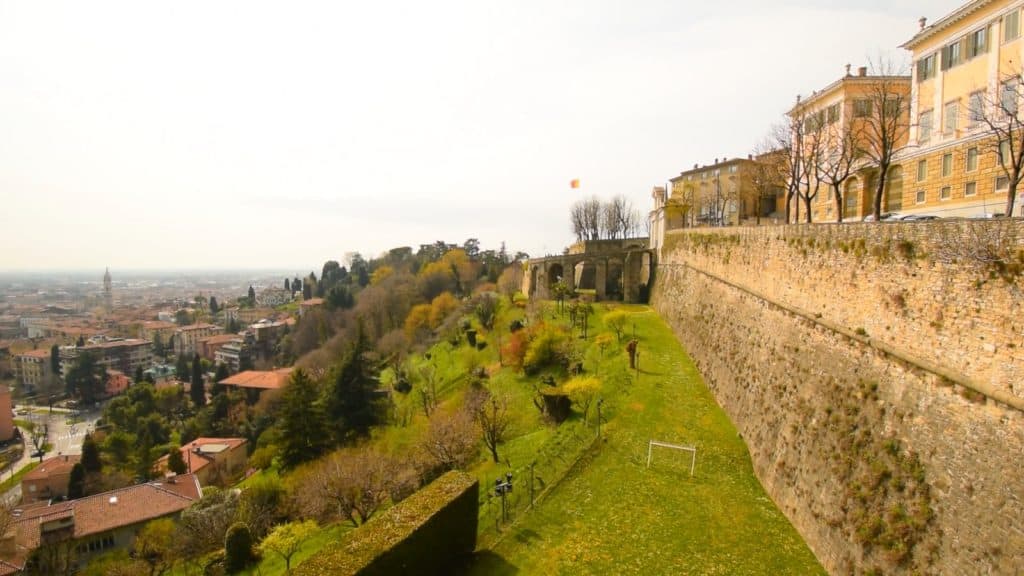
With mountains surrounding the crystal clear lake and several medieval towns around it, the lake has become a tourist attraction. Preserving the nature of the lake, a road was carved on the side of the mountains surrounding it to make transportation easier. Several islands are dotted on the waters of the lake and ferry rides run regularly to and from those islands.
Since 2018, the northern part of the lake known as Alto Sebino has been part of the UNESCO World Biosphere Reserve of “Valle Camonica – Alto Sebino.
6. Bellagio:
This municipality in the province of Como has mild weather during winter with temperatures rarely reaching 5 or 6 celsius and 30 degrees during the summer; providing the perfect weather for the growth of beautiful trees and flowers. Bellagio is located at the tip of the land the divides Lake Como in two.
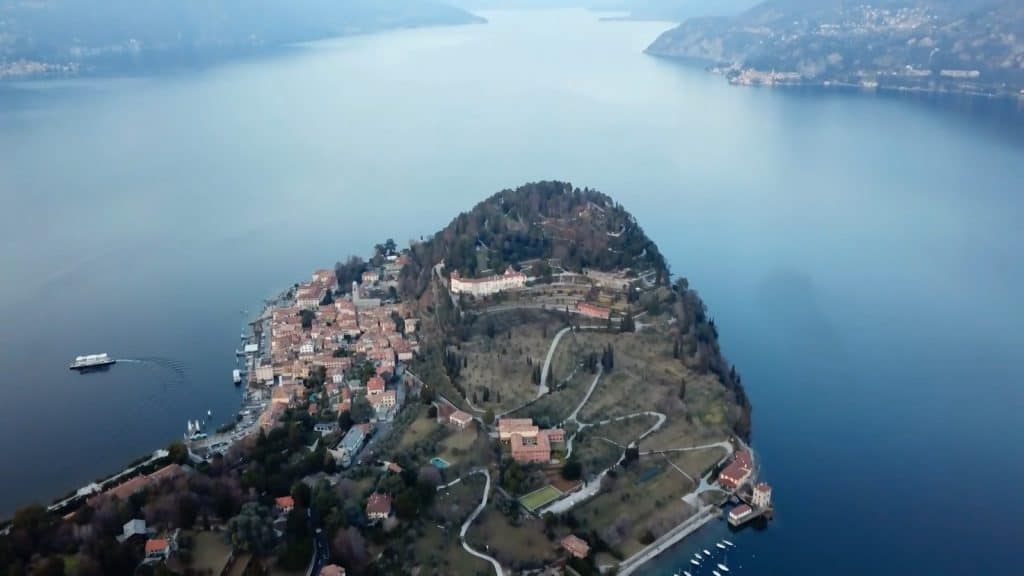
There are signs of human life found in Bellagio dating back to the Paleolithic period, signs of inhabitants can be found dating back to 400BC. The municipality has witnessed the Romans in 225BC, The Middle Ages starting in 568, The Renaissance period towards the end of the 13th century and the Napoleonic rule.
After the Italian Second War of Independence, tourism became the main source of income in the area and since then the municipality’s history was tied to its hotels. Hotels such as Hotel Metropole founded in 1825 and the Grand Hotel Bellagio (now the Grand Hotel Villa Serbelloni) opened in 1872.
They still operate until this very day mainly by the first families who founded them. Despite the fact that Bellagio became one of the first Italian resorts to gain world fame, it never became a place of mass tourism.
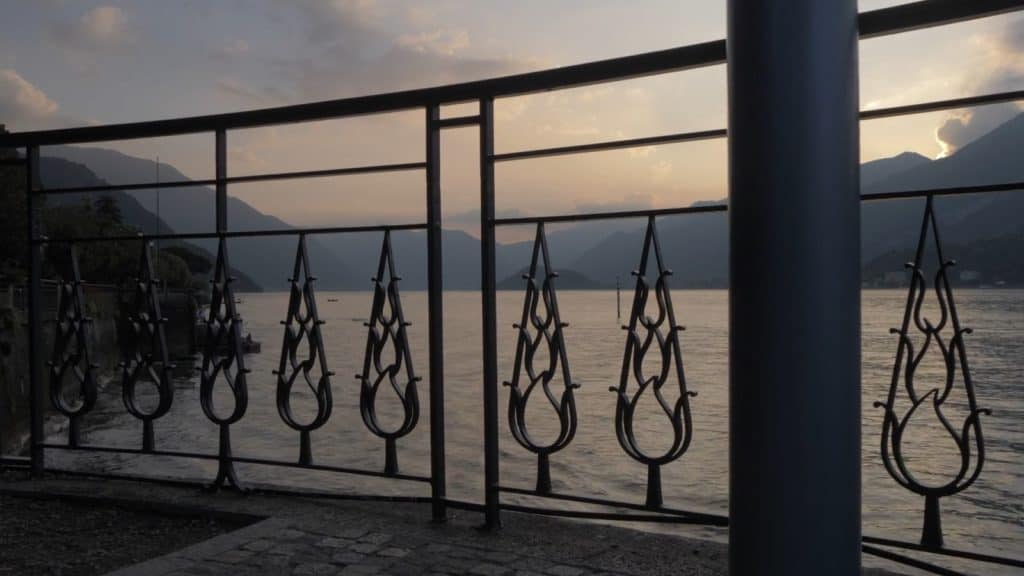
There are several churches dotted around the community of Bellagio, most notably is the Basilica of St. James and the church of Saint Giorgio. Some of the villas located in Bellagio are open for the public like Villa Serbelloni. The complex of the villa dominates the city center, though built in the 15th century, it was rebuilt several times later in history.
You can take one of many ways to reach the city of Bellagio. Through one of the nearest airports such as Linate Airport in Milan. All the while chartered seaplanes can land on the lake itself.
By train through several railway station near to it such as the Milan-Como line. A hydrofoil from Como or you can use car ferries. The road to Bellagio by car is really slow, narrow and winding.
Bellagio is home to many adventure sports such as rowing, cycling and trekking!
Festivals and Events in Lombardy
Several festivals and events take place in the cities of the region of Lombardy that you wouldn’t want to miss. We will explore these festivals according to the city in which they take place. So let’s get to it!
1. Festivals in Milano:
From religious to fashion festivals, the events taking place in Milano are very colorful!
- Festa di Sant’Ambrogio (7th of December):
Saint Ambrose is the patron saint of the city and his festival day is considered a public holiday. A church service takes place at the Basilica of Sant’Ambrogio then people flock to another festival highlight. The Oh Bej! Oh Bej! street market. The name literally meaning (how beautiful), where people get to try a variety of local foods and drinks while feasting their eyes on arts and crafts.
- Carnevale Ambrosiano (February):
The Ambrosian Carnival doesn’t have a fixed date, it varies every year according to religious tradition. The carnival takes place in Milan and wherever the Ambrosian rite is observed, about a week later than in the rest of the Italy. The most notable feature of the carnival is the wearing of masks and Milan’s typical mask is called Meneghino.
- Sagra di San Cristoforo (3rd Sunday of June):
Saint Christopher is the patron saint of travelers. His day is celebrated with music, fireworks and dancing along the banks of the river.
- Corteo dei Rei Magi (6th of January):
A traditional procession starts from the Piazza del Duomo and arrives in Sant’Eustorgio. It takes place on the day of the Epiphany and it is one of the oldest traditions in Milan. In the church-yard, a stage is set with characters from the Holy Family to whom the Magi bring gifts. Taking part in the procession is for the public and you can participate wearing the proper costume.
- Festa del Naviglio (First 10 days of June):
During the days of the festival, the area near the Naviglio canal in Milan turns into a folklore entertainment center. Theater shows, folklore music, dance shows and artistic handmade crafts make this festival worth an attendance. The festival ends with a mesmerizing torch parade. Due to the high numbers of tourists attending this specific festival, it’s always wise to check hotel rates and book your room in advance.
- Milan Fashion Week (Autumn/Winter in February/March and Spring/ Summer in September/October):
It’s no secret the attendance of this event is by invitation only. Should you be one of the lucky people invited you will get a sneak peak of the newest and most creative works in the world of fashion and trends.
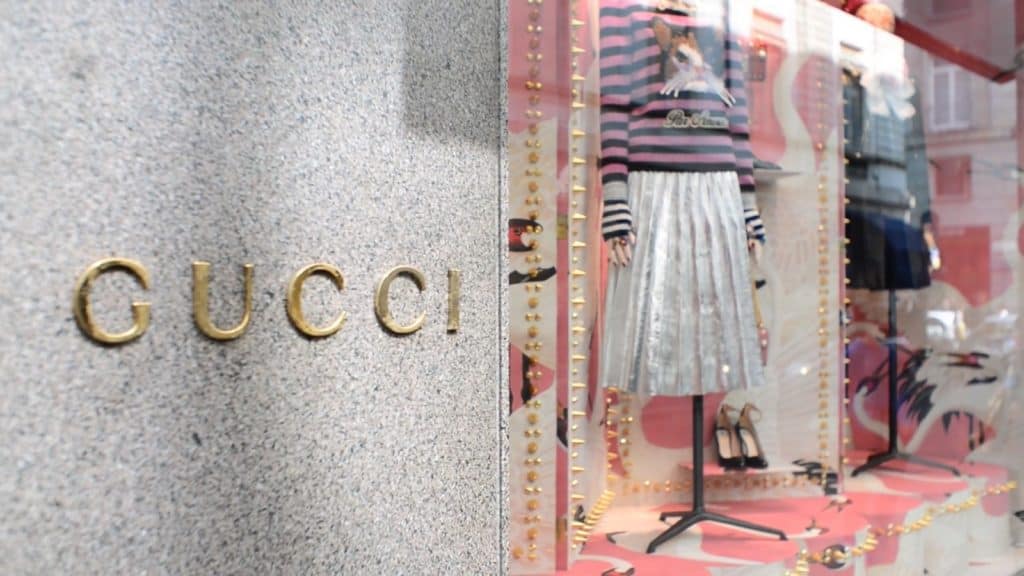
2. Festivals in Bergamo:
Most prominent festivals in Bergamo are music and dance festivals.
- Bergamo Jazz (Mid-March):
During this festival Bergamo becomes the world capital of jazz. The program of the festival differs every year as the organizers try their best in preparing the best program so the audience wouldn’t get bored.
The main venue of the festival is Teatro Gaetano Donizetti while the rest of the shows take place at clubs, bars and libraries. Bergamo also celebrates International Jazz Day which falls on April 30th through several street concerts.
- I-days festival (24th of June):
In the Monza Park, in conjunction with the patron saint of the city; San Giovanni Battista, a music festival and firework show takes place. The celebrations last four days and are characterized by loud music concerts and sporting events that take place at the park. You will listen to different types of music, from punk rock to pop music from world renowned artists.
- The International Piano Festival of Brescia and Bergamo (Late May to Early July):
Each year’s festival is dedicated to a different legendary pianist, the most recent edition of the festival was dedicated to the Polish composer and pianist Frédéric Chopin. Usually Teatro Gaetano Donizetti in Bergamo serves as the venue for this festival as well.
- Festival Danza Estate (June – July):
For more than 30 years, this festival has been the main live show event and the only show dedicated to contemporary dance in Bergamo. The entire city prepares for this festival, with shows featuring renowned dance artists. Shows designed especially for kids take place as well. These shows help introduce them to the world of dance with live shows suitable for their age group.
- Art 2 Night (18th of September):
Exhibitions of art work fill the city, libraries, museums, cafes and everywhere. This event comprises of five main cultural proposes. Tour, show, music, art and extraordinary openings. You can lose yourself in the different forms of art, paintings, sculptures, photography you name it!
- Grand Fondo Internazionale Felice Gimondi (8th of May):
This cycling competition will certainly get the adrenalin pumping through your veins. Competitors from both Italy and abroad take part in this event.
- Bergamo Historic Gran Prix (29th of May):
Collectors of vintage cars, mainly produced before 1975, are the main participants in this event. After the race, the cars that took part in the race are displayed in the Piazza Cittadella for the audience to marvel at.
- Notte Bianca dello Sport (8th of June):
On this day Bergamo transfers into a large-scale sporting event. The main purpose of this event is to promote sports among youth.
- Diving Competition at Italcementi Piscina (Mid-July):
There might not be a sea in Bergamo but that doesn’t stop the locals from holding a diving contest during which the city becomes the capital of diving. Competitors from all over the world take place and the fascinating event is covered by both national and international media.
- Notti di Luce (Early September):
On this event you will witness the city shining in bright colors, jazz festivals, exhibitions of fine art and photographs. A separate entertainment program is planned for children of all ages.
- Bergamo Scienza (1st to 17th October):
This annual science festival was established in 2003 with the main purpose of boosting the popularity of science. This festival consists of lectures, interactive workshops, exhibitions and meetings with scientists.
3. Festivals in Brescia:
Religious, racing and sports festivals and events take place within the boundaries of the city of Brescia.
- Millemiglia (May):
This vintage car race consists of a two day race to Rome and back again.
- The International Piano Festival of Brescia and Bergamo (Late May to Early July):
Part of this piano festival is dedicated to the Brescian musican Arturo Benedetti Michelangeli. The theme of the festival changes every year with concerts held in both Brescia and Bergamo. The Michelangeli Prize is the prize every classical orchestra aims to win as an honor to their contribution in classical music.
- Carnevale di Bagolino (February):
This colorful carnival of costumes is manifested by the Bälärì (the dancers and players) and the scary expressions on the masks they wear during the carnival. It is a carnival of color, folklore, tradition and good music. It takes place in the commune of Bagolino in the city of Brescia.
- Festival di Santa Giulia (June):
A veneration to Saint Giulia is held through beautiful music, arts, crafts and traditions of the region of Lombardy.
- Musiche dal Mondo (September):
This festival is a celebration of world-wide music and culture.
- Centomiglia (September):
This sailing event is one you’d love to attend, it takes place on Lake Garda where you can enjoy the competition and the scenic views of the lake.
4. Festivals in Como:
Historic, water-based and religious festivals characterize this city.
- Sangra de San Giovanni (Last week of June):
It literally means the feast of Saint Giovanni, this festival is characterized by illuminating Lake Como by floating lights. A firework show marks the end of this breathtaking feast.
- Palio del Baradello (11th of September):
The festival retells the fight that once took place between the people in the region and the Roman Emperor Frederico I di Svevia, il Barbarossa. It’s free to participate in the parade though registration is required beforehand.
- Palio Remiero del Lario (12th of September):
This is an annual rowing competiton.
5. Cremona, La Festa del Torrone (End of October):
The most delicious festival is the Nougat Festival where a re-enactment of the marriage of Francesco Sforza and Bianca Maria Visconti, at which nougat was first tasted in 1441.
6. Lecco, Folklore Festival (October):
During this folklore festival, locals dress in the traditional costumes and parade around the city on the beat of traditional music.
7. Lodi, Palio dei Rioni (October):
This festival is basically an iron horse race that’s organized by the Club Wasken Boys. It takes place at the Piazza della Vittoria in the city of Lodi.
8. Mantua, Chicco Ostiglia (Rice Festival):
Since rice is popular in the region of Lombardy, chefs compete in this festival to produce the best rice dishes they could come up with. World renowned food critics judge the competition to select a winner. Tours along the rice roads are also arranged.
9. Festivals in Monza and Brianza:
Two festivals take place in these communes.
- Formula 1 Motor Racing (September):
Several racing events take place at the tracks in Monza, Formula 1 Gran Prix is the most notable.
- Brianza Open Festivals (Winter/ Spring seasons):
Jazz festivals take place during the winter/spring season in Brianza. The city is filled with performers, music and concert stands where you can enjoy this genre of music.
10. Festivals in Pavia:
Two main festivals take place in Pavia.
- Festa del Ticino (One week in September):
This festival is both a cultural and sports festival, musical concerts, exhibitions, tours, shopping venues open all day to satisfy your love for shopping.
- Fiera del Tartufo, del Miele delle a Agricole dell’Oltrepo Pavese (November):
Literally Truffle and Honey Festival (Agriculture Production). This festival celebrates everything about truffle and honey, from the raw products to dishes that integrate the two ingredients.
11. Sondrio, Sagra di San Bello (February):
This festival Celebrates Saint Benigno De’ Medici, the founder of the Monastero di Berbenno. The festival is held in Berbenno di Valtellina. The festival consists of a morning procession through the city followed by a huge feast throughout the city accompanied with good music and general festivities all around.
12. Varese, Open Jazz Festival:
Several jazz festivals take place in the city all year round. The festivals include other genres of music as well and usually ends with a charitable auction.
Lombardy Cuisine
Often found in dishes and soups, rice is the most popular ingredient in the region and is used by locals to make different risotto recipes. One favored risotto is the one made with saffron called risotto alla Milanese. Cities around Lombardy add their own touch to the famous dish, such as adding sausages in Monza.
Polenta is another delicious dish through the region. The plains of Lombardy allows for intensive cattle raising which means a variety of cheeses such as Gorgonzola and Taleggio.
One of the most convenient dishes you can try are one pot dishes which you can make at home as well. Such dishes are like Casoncelli in Brescia and Bergamo, Pizzoccheri in Valtellina.
Other dishes include:
1. Cotoletta all Milanese:
This mouth-watering 1 inch-thick, bone-in veal cutlet fried in butter, can be found in different versions around the world. The dish is usually served with small tomatoes, a bit of grana, and arugula. Even though this is originally a Milanese dish, you can also find it in different restaurants around Lombardy.
2. Pumpkin Tortelli:
The people of Mantua use their locally produced pumpkin to make this delicious dish. The irresistible filling of local pumpkin, mixed with spices, amaretti cheese and mustard, it is served with melted butter, sage and grated cheese. This tortelli pasta dish will leave you asking for a second!
3. Polenta:
No one takes this traditional dish made with corn flour to the edge like northern Italians do. They top it with everything from ragù to mushrooms and cheese. They fry it, grill it, bake it and even more. A special variety is known as polenta taragna, which is made with cheese and a mixture of corn and buckwheat flours. Polenta is used in Italy as the base for many local dishes.
4. Cassoeula:
A heartwarming dish that’s native to the city of Milan and is made with the leftovers of meat and vegetables to keep you warm during winter nights. Although the dish is typically tied to the celebration of Sant’Antonio on January 17th, people start making it from October.
5. Panettone:
This big bread is enjoyed all over Italy during Christmas season but you have to try the Milanese version.
The story goes that the cook in the court of Ludovico il Moro of Milan was asked to prepare a great feast. Of the delectable desserts was a cake that the cook ended up burning and had to improvise and make one to compensate for the burnt cake.
Using only the ingredients he could find in the pantry, the cook used flour, eggs, sugar and raisins and created a new dessert for the guests to enjoy. The new dessert was a crowd pleaser and everyone wanted to know what it was called. Here the cook explained that it was “L’è ‘l pan del Toni” (Toni’s bread), from which the name “panettone” is derived.
6. Pizzoccheri:
The pasta in this classic Valtellina dish is made with buckwheat flour, mixed with butter, boiled potatoes, cabbage and Valtellina cheese before being served. Pizzoccheri is Perfect after a long day of hiking in Valtellina.
7. Risotto and Ossobuco:
You can’t say you’ve been to Milan until you’ve tried this dish. The juicy tender veal shank sitting atop the golden risotta.
8. Torrone:
Nougat is native to the city of Cremona is made from egg whites, honey, sugar and almonds. The Lombardy specialty is said have influenced by the Middle East.
Lombardy is a rich region in the north of Italy and undoubtedly rich in history, nature, sports, festivities and good food. If you’re ever planning a trip to Italy, Lombardy has to be on your schedule.
I guarantee you won’t be able to break free from the charms of the cities in the region, its soul-calming mountains and lakes, the fresh air filled streets and its soul food that will definitely keep you asking for seconds and coming back time after time!




